Environmental performance of underground coal gasification
E.V. Dvornikova Ergo Exergy Technology Inc., Montreal, QC, Canada
Abstract
Potential environmental effects of underground coal gasification (UCG) are addressed in this chapter. The degree of negative impact of UCG on the ecosystem in various mining, geologic, and hydrogeologic conditions is assessed. A classification of UCG-induced environmental factors impacting the ecosphere is provided. We summarize natural and man-made factors that cause varying degrees of groundwater contamination.
Experimental and calculated data on the formation and subsequent transport of the groundwater contamination plume during UCG are presented. The loci of contamination investigated are the operating gasifier and spent gasifier, as well as the aboveground condensate storage.
The results of experimental studies of the sorption of phenols by coal are presented. It was proved that the decrease in the concentration of phenols in groundwater along the migration path of groundwater flow is due to sorption, which leads to self-purification of the hydrosphere.
A host of effective environmental protection programs were developed to minimize hydrosphere contamination.
Keywords
Underground coal gasification; Groundwater protection; Potential contaminants; Contamination mechanisms; Protective measures
11.1 Introduction
In modern-day industrial applications, with sustained growth of production and energy consumption, the issues related to the impact on the environment gain prominence in analyzing the fuel and energy complex, including the effects on the hydrosphere, whose protection has over the last several decades been one of the pressing tasks confronting contemporary society.
Today's technological level of mining and use of solid fuels often results in a gradual transformation of some coal mining areas into ecological disaster zones.
It is well known that during blasting operations in open-pit mines, for each ton of explosives, depending on its type and specific consumption rate, 0.090–0.282 t of dust is thrown up into the air and 0.001–0.104 t of carbon oxides (A collection of methods for calculating air emissions in various industries, 1986).
When operating heavy mining machinery, such as excavators, bulldozers, conveyors, belt elevators, and dumpers, dust emissions range from 200 to 3000 kg/t of coal (accounting for dust suppression).
Burning waste rock spoils emits a significant amount of noxious gases: CO, from 0.8 to 1.0 t per day; CO2, from 2.0 to 7.5 t per day; O2, from 0.03 to 0.1 t per day; H2, 0.02 t per day; and OX, from 0.03 to 0.13 t per day. The total aggregate concentration of these gases in the air can reach 12–76 mg/m3 (Chekina, 1994).
Effluent with acidic pH and containing high concentration of TDS, often resulting from metamorphosed groundwater during coal mining, is one of the major contributors to environmental degradation. The amount of waste water with a concentration of TDS above 1000 mg/L is 44%, while groundwater with TDS values over 3000 mg/L constitutes as high as 34% of the total volume of water pumped from the mine drainage sumps. Mine drainage related to coal mining in Russia accounts for more than half of all industrial waste water discharge. US data show that acid mine drainage carries out more than 4 million tons of acid per year from operating and abandoned coal mines, with nearly 10,000 km of rivers and streams, and about 12,000 ha of water surface contaminated with acidic or alkaline water from coal mines.
The main groundwater contaminants in mine and quarry operations are the concentration of TDS and total suspended solids (TSS) (Parakhonsky, 1992). According to the VNIIOS Ugol Research Institute, only 5% of underground and open-pit coal mines have groundwater with a concentration of TDS up to 1 g/L (Technological schemes of cleaning from suspended solids and disinfection of mine waters, 1985). For the Kuzbass mines, the concentration of TSS in mine water can be as high as 1500 mg/L, with TDS values ranging from 0.5 to 1.5 g/L.
The most common organic contaminants found in mine and quarry water are phenols and petroleum compounds. The concentration of phenols can be as high as 0.01 mg/L and petroleum compounds as high as 13 mg/L. In some cases, exceedances of the concentration of concern were recorded for the following trace elements: cadmium 3–11 times, nickel 2–18 times, copper 10–20 times, zinc and manganese 2–200 times, chromium 5–123 times, and cobalt 2–27 times (Technological schemes of cleaning from suspended solids and disinfection of mine waters, 1985).
Both surface water and groundwater may be susceptible to contamination. Groundwater resource depletion may extend over enormous areas. For example, after the design depth of the open-pit mine was reached (500 m) in the Gubkinsko-Stoylensky oblast of the Kursk Magnetic Anomaly, the cone of regional groundwater depression had a radius of over 50 km.
One of the directions in improving the environmental performance of coal mining is the development of alternative, nonconventional techniques of in situ processing of coal into more ecologically friendly fuels (liquid and gaseous hydrocarbon products). One promising avenue is development and implementation of coal mining involving well drilling, of which underground coal gasification (UCG) is a prominent mining method.
In addition, the obvious and prodigious advantage of UCG is the feasibility of mining uneconomic coal resources that are not suitable for conventional mining and coal that occurs as local lenses.
11.2 UCG and environment
The suitability of employing the UCG method in a specific mining and geologic setting is largely a function of the effects that the UCG activities might have on the environment during all of the process stages.
Protection of the environment during UCG operations entails protection of the air, land, surface water, and groundwater.
Beyond doubt, the UCG technology offers advantages such as preserving the earth's surface and fertile topsoil; no additional stockpile areas are required for waste rock spoils or for coal storage. Using conventional mining techniques, the latter two represent one of the principal sources of environmental contamination.
The UCG method is also intrinsically socially beneficial compared with conventional coal mining techniques, as it eliminates the need for miners to be exposed to the extreme dangers and risks of underground coal mining.
UCG product gas is scrubbed and cooled and gas condensate treated and utilized in a closed-loop process without discharging gas directly to the atmosphere. A biological dephenolization unit was operated at the Yuzhno-Abinskaya UCG plant at the Kuznetsk coal basin since 1976 scrubbing 99.5% of phenols from the condensate, reducing the concentration of phenols from 2000 to 5 mg/L. Diluted treated water was discharged into the main city sewer interceptor line.
To prevent the ground surface depressions from forming, a special methodology was developed for calculating the safe dimensions of the coal pillars, which must be left in place. The optimal correlation between the depth of coal mining and coal seam thickness was determined, whereby no groundwater and gas-transmitting fractures developed within the overburden all the way up to the ground surface, which prevents significant gas leakage and gas bursts into the atmosphere. The spent wells are plugged and abandoned properly.
In addition, at the energy consumption stage, most of the environmental impact factors are deemed as less detrimental than solid fuels.
As a fuel, UCG product gas contributes to atmospheric contamination considerably less than coal. Table 11.1 displays the comparative values of the concentrations of air pollutants during combustion of various types of fuels. As can be seen from the table, no solid particles are present in the combustion products of syngas, while the nitrogen and carbon oxide content is lower than when burning solid and liquid fuels. The concentration of nitrogen oxides does not exceed 0.2 g/m3, with carbon oxides at 0.15–1.1 g/m3 (Antonova and Dvornikova, 1992).
Table 11.1
Hazardous components in combustion products of UCG gas, solid, and liquid fuels
| Fuel type | Concentration of hazardous components | |||||
| Coal | Liquid fuel | UCG gas | ||||
| vol% | g/m3 | vol% | g/m3 | vol% | g/m3 | |
| Particulate matter, ash, soot | – | 1.45–4.5 | – | 0.2–0.3 | – | – |
| Sulfur oxides | 0.05–0.34 | 1.6–11 | 0.031–0.2 | 1.0–7.0 | – | – |
| Nitrogen oxides | 0.02–0.07 | 0.6–2.0 | 0.007–0.04 | 0.2–1.0 | 0.007 | 0.2 |
| Carbon monoxide | 0.035–0.35 | 0.44–4.4 | 0.035–0.35 | 0.44–4.4 | 0.01–0.09 | 0.15–1.10 |

During gasification of high-sulfur coal, sulfur is converted to gas as hydrogen sulfide, which can relatively easily be isolated and used to recover chemically pure sulfur and sodium thiosulfate. Throughout the operation of the Podmoskovnaya UCG plant where lignite containing up to 3% sulfur was mined by UCG process, about 22,000 t of sulfur and 44,700 t of sodium thiosulfate were recovered (Antonova and Dvornikova, 1992). The gas was purified by the arsenic-soda method (Antonova et al., 1991).
In Russia, the sulfur oxide emissions of coal-fired boiler plants were as high as 7420 mg/mJ, with nitrogen oxide emissions of 4930 mg/mJ (Chekina, 1994). Data presented in (Corazon, 1991) showed that at coal-fired power plants, specific sulfur emissions were in the range of 720–2200 mg/mJ and nitrogen oxide emissions at 245 mg/mJ.
In addition, burning coal at coal-fired thermal power plants (TPPs) leads to a serious ecological problem, as significant amounts of ash and slag waste (ASW) are generated. According to the Russian Ministry of Energy, 30.4 million tons of ASW are generated annually by coal-fired TPPs. Coal ash disposal and storage sites containing 1.7 billion tons of ash and slag occupy a storage area of 28,500 ha (Kalachev, 2016). Ash storage facilities generally contain coal combustion residuals (unburned carbon), with ongoing chemical oxidation processes that often lead to fires in the coal ash impoundments. Oxidation and the interaction of ash impoundments with atmospheric precipitation lead to leaching of the mineral mass and active migration of many components, which leads to contamination of the hydrosphere.
UCG does not require waste rock stockpiling, thus providing a distinct advantage over conventional coal mining methods.
While protection of the ground surface from ground surface depressions and the air from contamination due to loss of gasifier seal integrity and water treatment of the surface plant are all part and parcel of the UCG technology, protection of groundwater resources presents the greatest challenge. Given the dynamic nature of groundwater, contaminants can be transported over great distances and enter aquifers located far away from the gasification sites.
Is it possible to minimize or prevent contamination of the hydrosphere? After all, groundwater present in the coal seam is brought into direct contact with the fire source during UCG.
The impact of the UCG processes on groundwater varies and is determined primarily by the specific geologic and hydrogeologic conditions of the coal deposit. The specific process conditions during UCG may also have a significant impact.
In the former Soviet Union, more than half a century of experience had been accumulated in scientific development and practical implementation of the UCG technology and environmental assessment of UCG plant operations. The experience acquired is unique and unsurpassed anywhere in the world. In situ coal gasification projects were operated in coal fields characterized by varying degrees of complexity of geologic and hydrogeologic conditions. These were flat-lying to subhorizontal deposits such as Basovskoe, Gostevskoe, and Shatskoye coal deposits in the Moscow coal basin and the Yuzhno-Sinelnikovskoye coal deposit in the Dneprovskoe coal basin and geosynclinal-type coal deposits: Lisichanskoye coal deposit in the Donetsk coal basin and Kiselevskoye (the Yuzhno-Abinsk site) in the Kuznetsk coal basin. The Angren lignite deposit in Central Asia (Uzbekistan) belongs in an intermediate position in the classification.
Two short-term UCG trials were conducted on bituminous coal with a low volatile matter content: anthracite (A) in Shakhty City and semianthracite (SA) in Kamensk. As a result of these trials, such coals (anthracite and semianthracite) proved nonsuitable for UCG due to mechanical instability of the heated reactive surface of the gasification channel underground.
Research programs in UCG were initiated and conducted in the United States (Hoe Creek, Hanna, Carbon County, Centralia, and Rawlins) and in Western Europe.
During the period between 1999 and 2003, a commercial UCG project was operated at the Chinchilla coal field in Australia (Walker et al., 2001).
A pilot scale UCG project at the Majuba coal field, South Africa, to supply a combined steam-gas cycle power plant continues to operate in a subhorizontal bituminous coal seam. The new UCG site with a capacity of about 3 PJ per year was completed and ready for commissioning; planned shutdown is still ongoing at the old site where UCG activities were concluded.
Based on years of experience in operating UCG projects, the principal process parameters were defined, and patterns of man-made hydrolithosphere change were identified during UCG operations (Table 11.2) (Dvornikova, 1996a,b,c).
Table 11.2
The main indicators of human impacts on the hydrolithosphere during UCG operations
| Type of human impact | Nature of impact | Type of man-made change | Nature of man-made change | Nature of physical and chemical processes |
| 1 | 2 | 3 | 4 | 5 |
| Conversion of solid coal using the UCG method | Thermal (thermobaric/PT) | Extraction of solid fossil fuel deposits | Changes in geodynamic conditions | Increase in transmissivity of overburden (hydraulic conductivity, porosity) |
| Changes in thermobaric conditions (temperature and pressure) | UCG product gases dissolving in groundwater (saturation) | |||
| Heat penetration of rock and groundwater, decreased density and viscosity of water | ||||
| Emergence of thermal springs | ||||
| Increase in groundwater storativity (sorptive capacity) of rock, the formation of ash, slag, calcined, or sintered rock | ||||
| Chemical | Increased rates of geochemical processes | Changes in geochemical conditions | Increase in the chemical potential (dissolving ability) of groundwater | |
| Transition of chemically and physically bound groundwater and fracture groundwater, as well as gravitational groundwater, to a vapor state, transformation of water to superheated steam | ||||
| Formation of pyrogenic water | ||||
| Contamination of groundwater in aquifers by gasification products | Changes in groundwater chemistry, influx of contaminants | Solid rock, gases, organic components dissolving in groundwater | ||
| Increase in the concentration of TDS, macro- and microcontaminants in groundwater | ||||
| Increase rates of physical, chemical and biochemical processes of interaction between contaminated groundwater and naturally occurring groundwater | Suspended and emulsified materials trapped by rocks | |||
| Dilution of contaminated groundwater by clean naturally occurring water | ||||
| Molecular diffusion, dispersion, absorption of specific components (physical and chemical sorption), gas production, heat transfer | ||||
| Contamination of rock material | Changes in physical and chemical properties of soil and rock | Elevated tar and silt content of soil and rock | ||
| Ash and slag waste, calcined rock, tars, oils accumulate in the depleted gasification cavity | ||||
| Geodynamic | Deformation of the overburden | Rock deformation | Subsidence | |
| Rock deformation zone propagates up to the ground surface with resultant discontinuities | Increased fracture density of rock | |||
| Changes in transmissivity of the overburden | Increase in the zone of gas leakage, increased aquifer recharge from infiltration | |||
| Connectivity of the gasification cavity with gas-permeable rock layers and aquifers | ||||
| Increased transmissivity, storativity, and sorption properties of rock | ||||
| Increased rates of man-made geodynamic processes | Increased rates of suffusion/suffosion and karsting | Rock dissolving or subjected to leaching | ||
| Abstraction of groundwater | Hydrodynamic | Decreased operational freshwater resources | Changes in hydrostatic pressure | Changes in hydraulic connectivity between aquifers |
| Changes in groundwater flow direction | ||||
| Increased piezometric gradient (hydraulic gradient) and flow velocity of groundwater | ||||
| Lower boundary of oxidation-reduction potential | ||||
| A deep groundwater depression | ||||
| Area of dewatered rock | ||||
| Operation of aboveground liquid waste storage facilities | Chemical | Contamination of rock in the vadose zone (aeration zone) | Changes in the chemical composition and transmissivity of the overburden strata | Increased silt and tar content of rock |
| Precipitation of contaminants at the bottom of the settling pond | ||||
| Changes in permeability and transmissivity values of the overburden strata | ||||
| Man-made aquifers forming | Changes in the chemical composition of alluvial groundwater due to contaminant infiltration | Increased hydrostatic pressure | ||
| Increased rates of rock dissolution | ||||
| Increased concentration of TDS, groundwater contaminants | ||||
| Increased rates of physical, chemical, and biochemical processes | Molecular diffusion, dispersion, absorption (sorption) of select components |
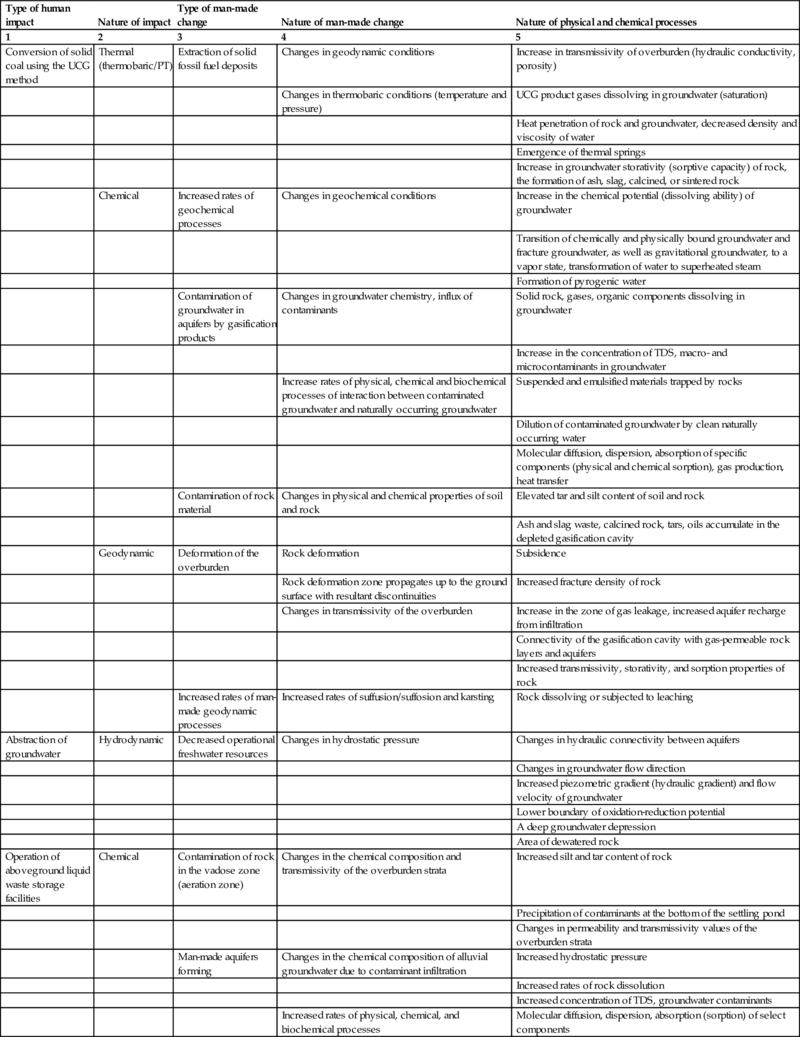
Three major types of human impact on the hydrolithosphere are differentiated:
1. In situ conversion of coal to a gaseous fuel consisting of multiple physical and chemical reactions under conditions of high temperature and pressure leading to contamination of groundwater, which reduces the total amount of coal resources, with formation of gasification cavities;
2. Abstraction of groundwater that may lead to an overall drawdown in freshwater reserves and changes in hydrostatic pressure of aquifers;
3. Operation of aboveground condensate storage facilities, which may create conditions for the formation of man-made aquifers and sediment.
The types and nature of man-made changes to the hydrolithosphere were identified, as well as the nature of the physiomechanical and physiochemical processes inherent in the UCG technology, which largely determine the degree of groundwater contamination. The latter include changes in geodynamic, hydrodynamic, thermobaric, and geochemical conditions in gasification areas, accompanied by various physical and chemical processes occurring in the rock formation.
UCG activities generate contaminants as unwanted by-products that can adversely affect the environment at the UCG plant location. Significant aspects of impact of the UCG process on the environment are presented in Fig. 11.1.
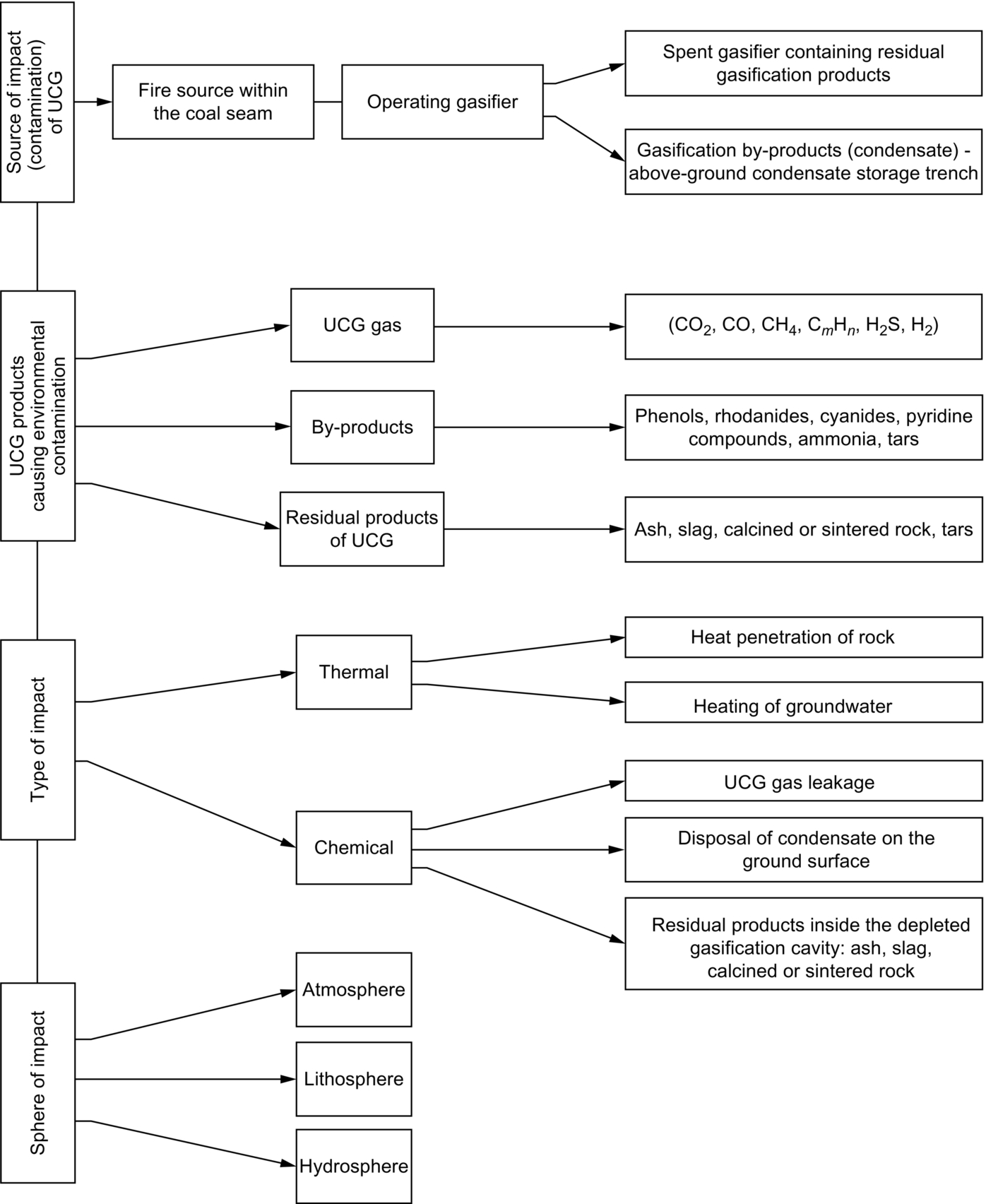
Potential sources of contamination of the geologic setting and groundwater in particular are
− the fire source of the operating gasifier and gas leakage,
− gasification cavities of spent gasifiers,
− aboveground condensate discharge and storage dams and discharge of condensate along gas pipelines.
The principal sources of contamination are the fire source proper within the coal seam and gasification products (CO2, CO, H2, CH4, CmHn, and H2S) and gasification by-products (phenols, tars, ammonia, cyanides, benzenes, pyridine compounds, etc.) as well as the residual products of gasification in spent gasifiers (ash, slag, and tar) that can enter groundwater and migrate over considerable distances.
Untreated hot UCG product gas as it is collected at the surface from the production well is a mixture of steam/water vapor products of both complete and incomplete carbon combustion, dioxide and water vapor reduction reactions, reactions of coal pyrolysis, and conversion reactions of water vapor and combustion reactions of gaseous products.
The above reactions involve not only the injection agents fed into the coal seam from the surface but also groundwater, moisture, and carbon-containing components of rock surrounding the coal seam.
Sulfur compounds contained in the coal and rocks undergo conversion to gaseous state as they come into contact with oxygen, hydrogen, and water vapor.
As the vapor/gas mixture cools, it separates into a liquid (condensate) and gaseous phase. When left standing, the condensate settles out into an above-the-tar water solution layer containing multiple chemical compounds and tar. The highest concentrations of noxious components are found in the gas condensate: approximately 1–2 g/L of phenols, 4–25 mg/L of cyanides, 2–5 g/L of dissolved ammonia, tars, and pyridine compounds.
Gas condensate enters the surface storage, which can also be a source of contamination of both the atmosphere and the hydrosphere. However, when the condensate storage dam is installed properly and condensate is treated and utilized, which can be achieved through relatively simple means, contamination from the surface-based contamination source can be reduced to zero.
An important characteristic of UCG is the production of most contaminants along with hot gas to the ground surface as condensate. As can be seen from Table 11.3, samples collected simultaneously had a concentration of phenols, rhodanides, and cyanides thousands of times higher in the condensate than in water pumped out from the underground gasifier (Table 11.3).
Table 11.3
Contaminants in gas condensate and water samples collected from Gasifier 17 of the Yuzhno-Abinskaya UCG plant (Kuznetsk coal basin)
| No | Sampling point, Date | Phenols (mg/L) | Cyanides (mg/L) | Rhodanides (mg/L) | Ammonia (mg/L) | |
| Volatile matter | Nonvolatile matter | |||||
| 1 | Gas condensate produced from Well 7G, May 1991 | 1366.4 | 32.9 | 75.8 | 530.7 | 2602 |
| 2 | Groundwater From Well 39, which had connectivity with production Well 7 May 1991 | 0.09 | Not detected | 0.18 | Not detected | 8.2 |

However, the really important question is what percentage of contaminants remains in the underground gasifier. Assessing the degree of contamination of groundwater and determining the extent of the plume and the rate of its migration require that both the naturally occurring and man-made factors (mining, geologic, and hydrogeologic conditions of the coal field) be evaluated in each specific case, as they determine the degree of contamination.
11.3 Major factors affecting the groundwater chemistry and contamination of groundwater during UCG
Generalizing from many years of experience in in situ coal gasification at UCG stations located in various coal basins, it can be stated that the degree of impact of UCG on aquifers varies and is determined not only by the specifics of the UCG process itself but also by natural factors characterizing the deposit.
The classification of the factors contributing to groundwater contamination is presented in Fig. 11.2 (Dvornikova, 1996a,b,c; Dvornikova and Kreinin, 1993).
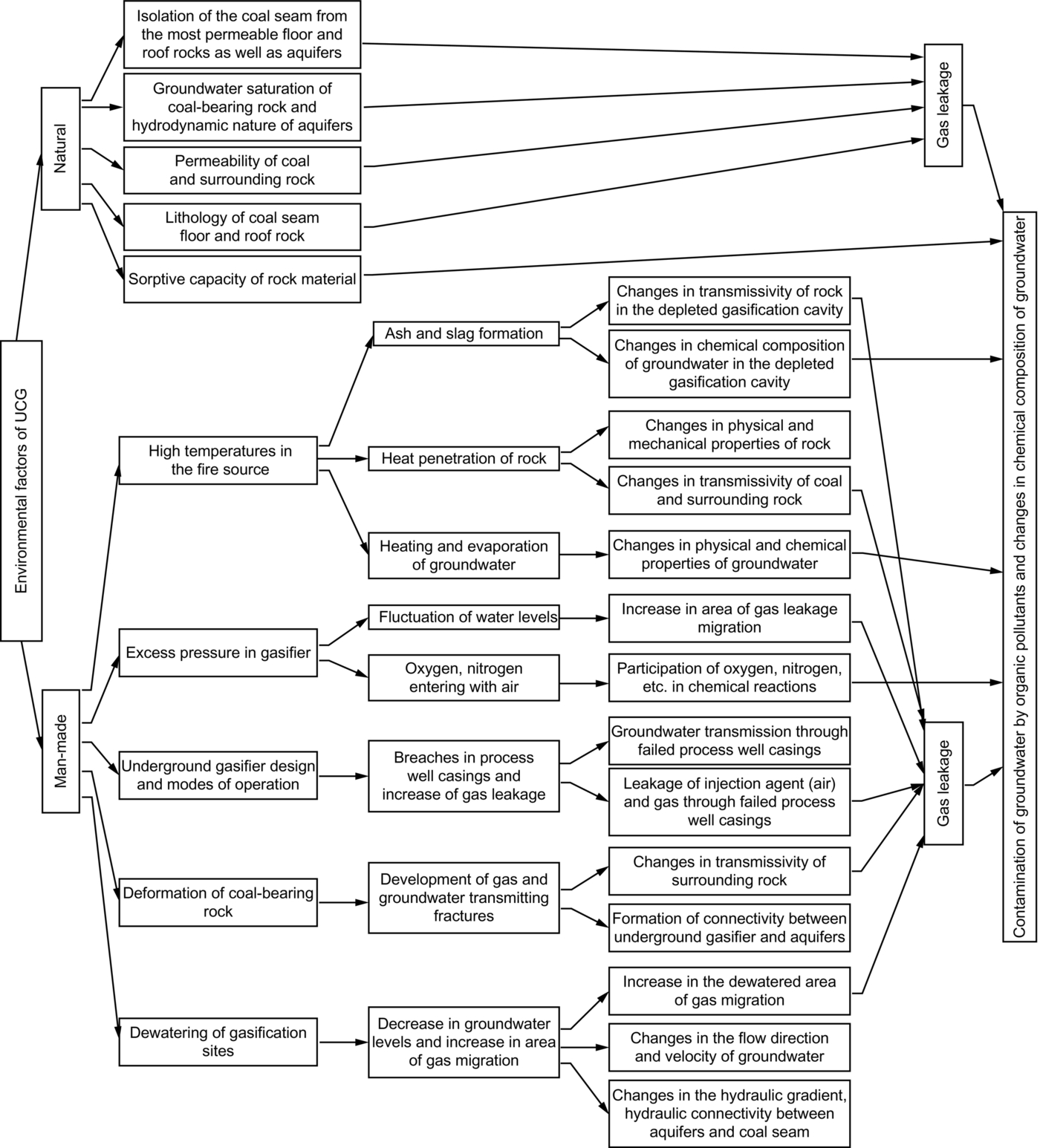
During UCG, the possibility of environmental contamination including groundwater is mainly related to gas losses from underground gasifiers. Gas leakage at the operating UCG plants was generally between 7% and 30%.
Important man-made factors that have a significant impact on groundwater include the following:
I High temperatures at the fire face (up to 1200–1300°C) and inside the gasification cavity
II Overpressure in the underground gasifier
III Gasifier design and gasification mode of operation
IV Deformation of coal-bearing rocks of the roof and floor due to the processes of rock deformation and impact of high temperature
V Gasification site dewatering and water extraction from gasification cavities (Dvornikova and Kreinin, 1993)
A high-temperature profile at the fire source and long-term temperature anomalies have a significant impact on the hydrogeochemical groundwater conditions and their variations over time.
High temperatures cause changes that affect physical and chemical properties of rock and groundwater. A gas/vapor mixture zone forms in the immediate proximity to the fire source of combustion. Pyrogenic waters are formed, which are characterized by a different chemical composition. Part of the water transitions from the droplet liquid phase to steam, which comes into contact with the gasifier gases, becomes saturated with organic components, migrates through the rock strata and, after condensing once again, enters the aquifers.
As the groundwater temperature rises, its physical and chemical properties change:
− Dissolving ability (chemical activity) of water increases.
− Water density decreases (the volume of the liquid increases).
− Water viscosity decreases.
Various chemical components are carried out with vapor-phase water as it migrates through heated rock.
High temperatures cause changes that affect physical and chemical properties of overburden and underburden strata. Rock generally fractures and loses its aquitard properties. Hydraulic conductivity values increase and so do permeability and reservoir properties of heated rock strata, which can result in increasing gas leakage and its migration over considerable distances, thus potentially increasing the possibility of aquifer contamination. Therefore, the presence of aquitards of certain thicknesses and weakly permeable strata in the coal seam floor and roof, which is an integral part of operating the UCG process, is conducive to minimizing the environmental impacts on the hydrosphere.
Due to rock deformation in overburden strata and the impact of high temperature, zones of higher permeability and open groundwater-transmitting fractures form, which can lead to larger plume dispersions of migrating gas. The presence of poorly permeable, groundwater-saturated rock in the overburden generally prevents the spread of gas leaks.
Variations in the degree of environmental contamination may be attributed to overpressure in the underground gasifier, which determines the amount of gas leakage. Increasing pressure in the gasifier may result in increased gas losses. The greater the additional flow resistance created by weakly permeable groundwater-saturated rock, the lower the gas loss increase rate. As the pressure in the gasifier increases and as the conductivity properties of heated rock mass increase, as concurrent dewatering activities in the gasification site result in increasing area of dewatered rock, gas leakage can increase dramatically. However, as a result of drainage activities and water extraction in the vicinity of the UCG site, a cone of groundwater depression will develop, which precludes migration of contaminants beyond its boundaries. Contaminated groundwater is pumped via water extraction wells to the surface, where it is treated with all known available and reasonable technology. Contamination of groundwater is contained within the vicinity of water extraction wells.
UCG modes of operation and the gasifier design of the gasifier may have a significant effect on groundwater contamination. As can be seen from Table 11.4, the chemistry of the gas condensate collected at the same gasification site but during different gasification modes of operation is different (samples 1–3). The gasifier design also has a significant effect on possible contamination of the hydrosphere. As vertical wells are drilled in the gasifier, aquifer contamination may occur through breaches in process well casings due to rock deformation of overlying strata. New designs of underground panels and vertical production wells have successfully resolved this problem and ensure excellent environmental performance of UCG systems built using vertical process wells.
Table 11.4
The chemistry and gas composition of the condensates
| UCG site | Sample no. | Date sampled | pH | Dry solid residue (mg/L) | Sulfur content (mg/L) | Oxidation resistance in O2 (mg/L) | Chemical component composition (mg/L) | Cl− | F− | SO42 − | HCO3− | |||||||
| Total | After calcination | NH4 | Na+ | K+ | Ca2 + | Mg2 + | Al3 + | Fe2 + + Fe3 + | ||||||||||
| Podmoskovny (sandy clay rocks) | 1 | 3 Sep 1958 | 6.6 | 2272 | 643.5 | 1056 | 1692.0 | 715.0 | 2.21 | Not measured | 25.8 | 2.41 | 15.0 | 240.0 | 2.0 | 2.0 | 1.0 | 738.0 |
| 2 | 22 Jun 1959 | 5.2 | 27,810 | 2415.0 | 6325 | 5724.0 | 4112 | 11.0 | 25.0 | 55.0 | 21.0 | 120 | 681.0 | 248.0 | 18.0 | 4.0 | - | |
| Lisichansky (sandy shale rocks) | 3 | 6.4 | 14,705 | 1388.0 | 3976 | 5317.0 | 4333 | 8.0 | 24.0 | 19.0 | 19.0 | 100 | 997.0 | 255.0 | Not measured | 4.0 | 227.0 | |
| 4 | 8.2 | 2342 | 2204 | 2480 | 1480 | 1258 | 14.0 | Not measured | 59.0 | 58.0 | 4.5 | 15.0 | 152.0 | – | 289.0 | 212.0 | ||
| UCG site | S2 − + HS− | SO4− | S2O42 − | Si | Ti | Mn | Cu | Chemical component composition (mg/L) | ||||||||||
| Zn | Sr | Ba | Ag | Be | V | Sn | Cr | Pb | Ge | |||||||||
| Podmoskovny (sandy clay rocks) | 488.0 | 11.0 | 0.02 | 12.0 | 0.1 | 1.0 | 0.5 | 15 | 0.03 | None | None | 0.005 | 0.001 | Not detected | ||||
| 858.0 | 780.0 | 4598 | Not measured | |||||||||||||||
| Lisichansky (sandy shale rocks) | 775.0 | 10.0 | 5604 | 28.0 | 0.3 | 1.1 | 0.03 | Not detected | 0.006 | 0.006 | 0.001 | 0.11 | – | |||||
| Trace | 732 | 2461 | 13.0 | 0.05 | 0.11 | 0.05 | 0.45 | Not detected | – | Not detected | 1.1 | – | ||||||
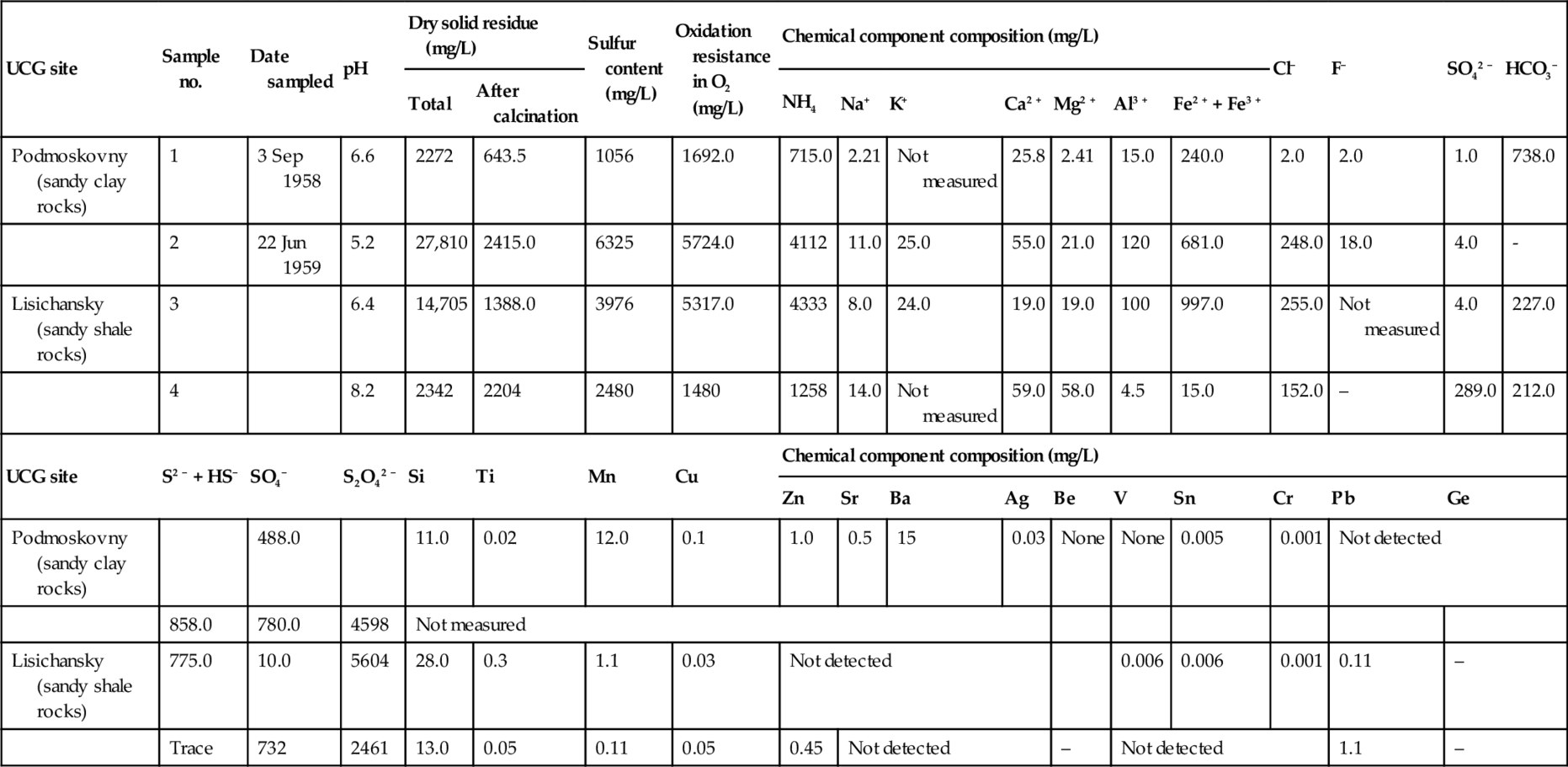
Leaks from an underground gasifier are detected not only using process-related parameters, pressure, viscosity of the gas losses, dimensions of the gasification cavity, temperature, etc., but also primarily by the distance from the gasification cavity to the plume boundaries, the thickness and permeability of the surrounding layers, the degree of isolation of the coal seam, the amount of groundwater saturation of the rock strata, that is, by the naturally occurring conditions, or, alternatively, the geologic and hydrogeologic conditions of the coal deposit.
There is a varying degree of impact of UCG on groundwater conditions and its contamination in different mining and geologic settings. Important natural factors that determine the degree of groundwater contamination include the following:
I. Isolation of the coal seam from the most permeable floor and roof rocks and aquifers
II. Permeability of the surrounding rock and coal seam
III. Groundwater saturation of coal-bearing rock and hydrodynamic nature of aquifers
IV. Lithology of the floor and roof rock of the coal seam
V. Sorption properties of coal and surrounding rock
One of the most important natural factors is the isolation of the coal seam. When a thick layer of dense, virtually aquiclude rocks (clays) occurs in the floor and roof of the coal seams, which are persistent along the strike and thickness, which serve to isolate the coal seam, the possibility of contamination is effectively excluded (Antonova and Dvornikova, 1992).
The permeability of the surrounding rock and coal seam has a significant impact on the contamination of groundwater. Rocks with high gas permeability (karsted fractured limestone and sandstone) occurring in the roof and floor of the coal seam may lead to significant gas leakage from gasifiers, leading to contamination of groundwater over a wide area.
If rocks with low permeability (siltstone, mudstone, and clays) occur in the roof and floor of the coal seam, the possible resulting contamination of groundwater is insignificant. The coal seam and surrounding rock with low permeability ensure the underground system integrity of the gasification panels and reduce gas leaks, which reduces the degree of negative impact of UCG on the environment including groundwater and also minimal rates of migration of the contaminated flow over considerable distances.
Essential for mitigating the negative impact of UCG is groundwater saturation, the pressurization of the system encompassing the entire coal-bearing rock unit with very low hydraulic conductivity values (hydraulic conductivity of 0.0001–0.01 m/day), which serve as hydrolock of sorts preventing gas leakage.
Such factors as the hydrodynamic nature of aquifers, the zone of groundwater recharge, groundwater flow, and discharge that affect the variations of possible contamination over time and determine the rate and direction of groundwater flow play a significant and deciding role in contaminant migration.
The lithology of the floor and roof rock of the coal seam determines the groundwater chemistry. As mentioned above, when considering man-made factors, high temperatures cause vapor-phase water to leach chemical elements from the surrounding rock, which affects the chemistry of the condensate and the chemical composition of the groundwater.
In addition, the main lithologies of floor and roof rock influence the formation of gas-transmitting fractures in the overlying and underlying rock strata. When dense and plastic rocks (clays) occur in the roof of the coal seam, smooth subsidence of the overlying rock and filling of fractures were noted, which reduces gas leakage from the underground gasifier and mitigates the risk of groundwater contamination.
The natural sorption properties of coal and surrounding rock have a significant influence on the degree of aquifer contamination and affect the processes of self-purification of groundwater. In addition, high temperatures generated from combustion of plant remains and decompaction occurring in the coal-bearing formation causes an increase in rock porosity, storativity, and sorption properties. Increasing permeability and porosity of rocks results in a large reactive surface area, which in turn leads to an increase in the sorptive capacity of rock.
11.4 Environmental performance of UCG in the former USSR
Comparative analysis of the results of hydrogeochemical studies in various geologic and hydrogeologic settings and environmental impact analysis of UCG plants suggest that in areas where there are no aquitards of persistent thickness occurring in the floor and roof of the coal seam, and with presence of an unconfined aquifer in the floor of the coal seam, situated in fractured, karsted rocks, the upper 10 m of which was not under water, it was not possible to prevent contamination of groundwater. In such gasification sites, migration of gas leaks through aerated rock was recorded over a wide area, which led to contamination of the aquifer. Gas leakage was as high as an average of 30% and less frequently, 40%. As can be seen from Fig. 11.3 (Kononov, 1965), the concentration of phenol in the immediate vicinity of the gasification site in the underlying Upinsky aquifer was as high as 0.04 mg/L. The farther away the location of monitoring wells from the gasification site, the lower the concentration of phenol in the samples all the way to values below the maximum allowable concentration levels. So, the concentration of phenols did not exceed 0.009 mg/L within a radius of 1.5 km, while at a distance of 3 km, the concentration of phenols did not exceed the maximum allowable concentration for drinking water (MAC = 0.001 mg/L). These UCG panels at the Podmoskovnaya UCG plant were not deemed suitable for mining using the UCG method.
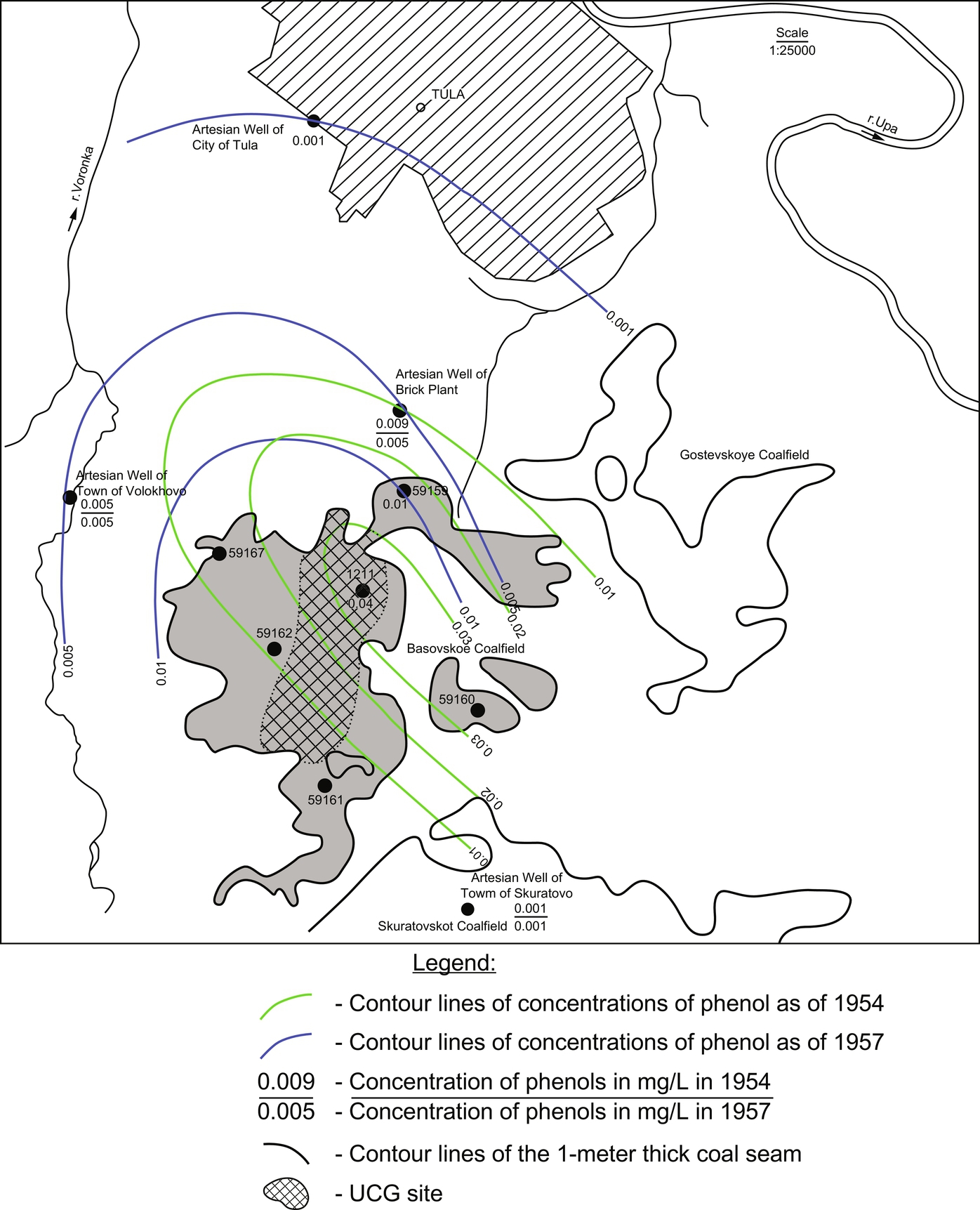
Comparative analysis of the results of geochemical studies in the adjacent panels at the Podmoskovnaya UCG plant showed that in select zones where the coal seam was flooded under confined groundwater conditions by groundwater of the underlying aquifer, with clay layers of sufficient thickness occurring in the floor and roof of the coal seam, contamination was minimal. Confined groundwater of the underlying Upinsky aquifer served as a natural hydrolock precluding contaminant migration. Water extraction from the underlying aquifer ensured the containment of contaminated water within the vicinity of water extraction wells. Subsequent to the completion of gasification and water extraction operations, the concentration of phenols decreases to values below the MAC. This finding proved that contamination may remain localized.
It is important to underscore that as compared with conventional mining methods, the UCG technology as applied in the Podmoskovny Coal Basin (open-pit development) is the safest and most environmentally friendly. In the Podmoskovny Coal Basin, the UCG sites and open-pit mines share the same mining and geologic conditions. As can be seen from Table 11.5, compared with open-pit development, change in the groundwater chemistry was less significant during UCG within the deep coal seam aquifer in depleted gasification panels. The pH of groundwater is neutral (pH 7.0–7.5) both in the zone of circulating gas/vapor mixture and at a distance of 30–40 m from the gasifier, which is consistent with the baseline values for the deposit. However, the condensate sample collected from the production well is characterized by extremely high concentration of TDS (12,473 mg/L), slightly acidic pH (pH 6.4), and high iron content (997 mg/L), which indicates that during UCG, the preponderance of contaminants is brought up to the surface where it is collected in the condensate storage dam. During UCG activities in the deep coal seam aquifer, inside the zone of influence of UCG, a certain amount of increase in the concentration of TDS is recorded, from 253 mg/L (baseline value) up to 1243–1373 mg/L (Kononov, 1965). In comparison, at the Ushakovsky and Kimovsky open-pit coal mines located in the Moscow region, where the same lignites were mined in similar geologic and hydrogeologic conditions, there exist to the present day dozens of man-made “dead” water reservoirs that had formed in depleted areas, that is, in the cutting trenches. The pH of water in such reservoirs is highly acidic environment, with a pH of 2.7–5.0, concentration of TDS from 1500 to 4460 mg/L, and extremely high iron content (25–531 mg/L) and SO4 ions (1000–3100 g/L) (Dvornikova et al., 2001). The trace element composition shows high concentrations of highly hazardous lithium, extremely harmful beryllium, dangerous manganese, iron, aluminum, nickel, and cobalt. The sulfur content is as high as 725 mg/L. Figs. 11.4 and 11.5 show the presence of ferruginous sediments and sulfur deposits, which in arid years crystallized during evaporation in the riparian zones of the “dead” water reservoirs, and an absolutely lifeless, lunar-like landscape at the abandoned sites (Fig. 11.6).
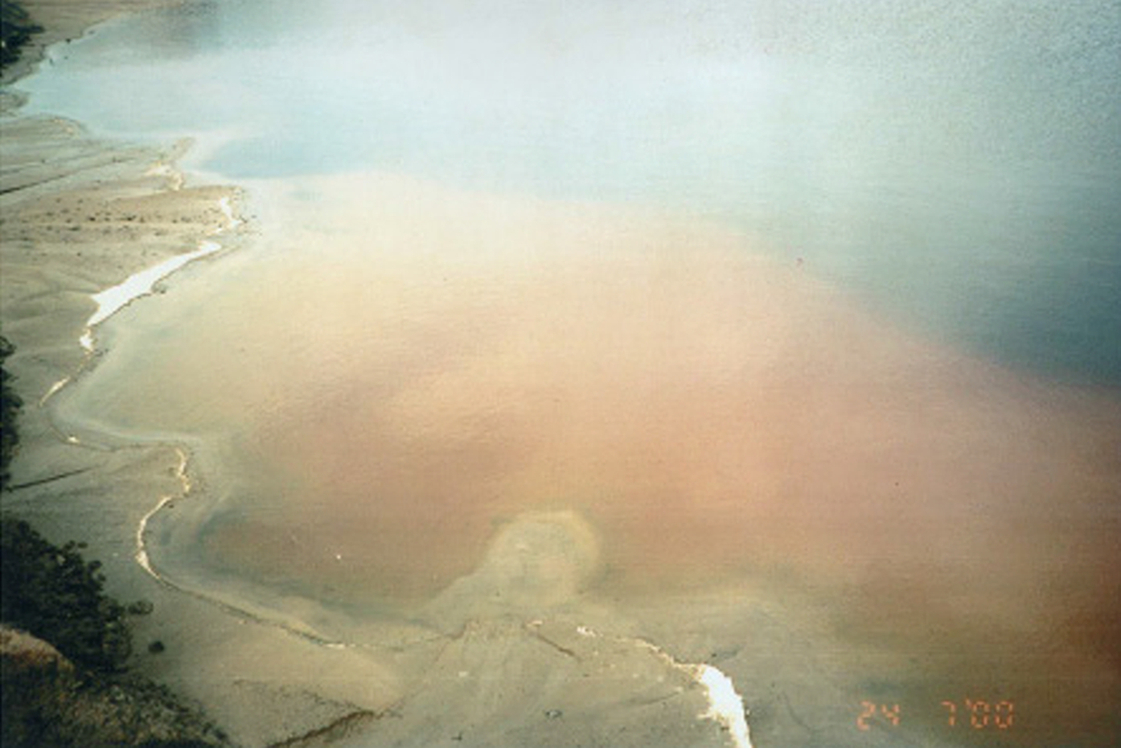
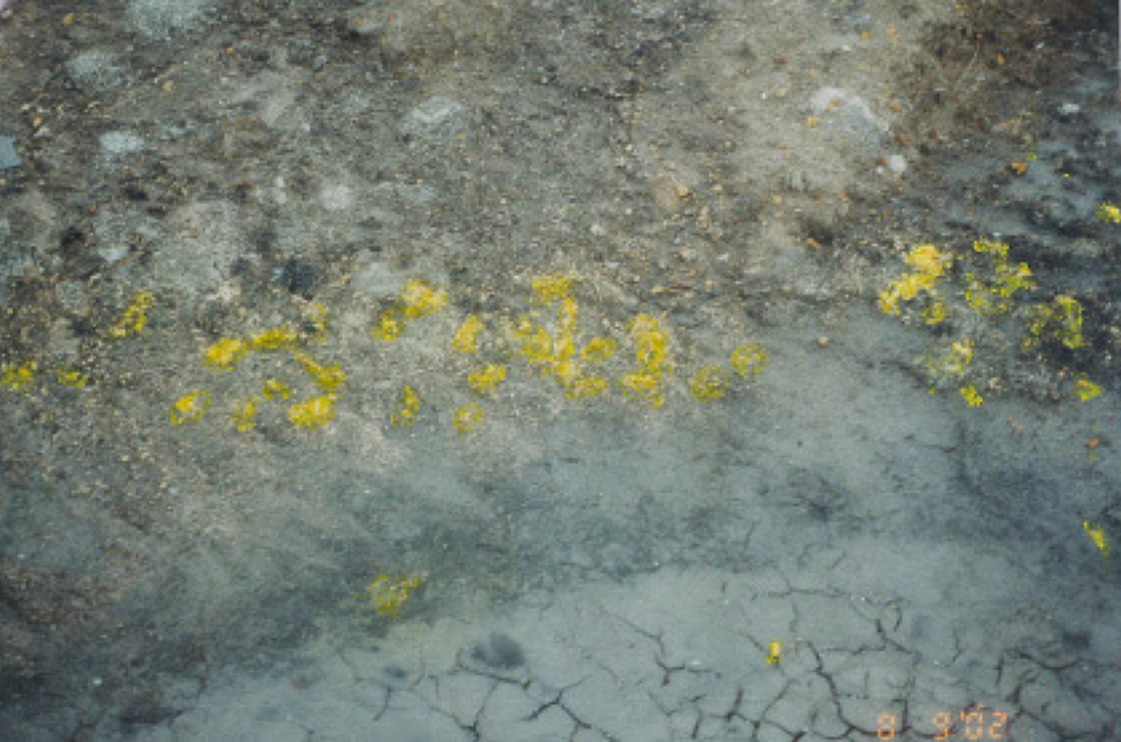
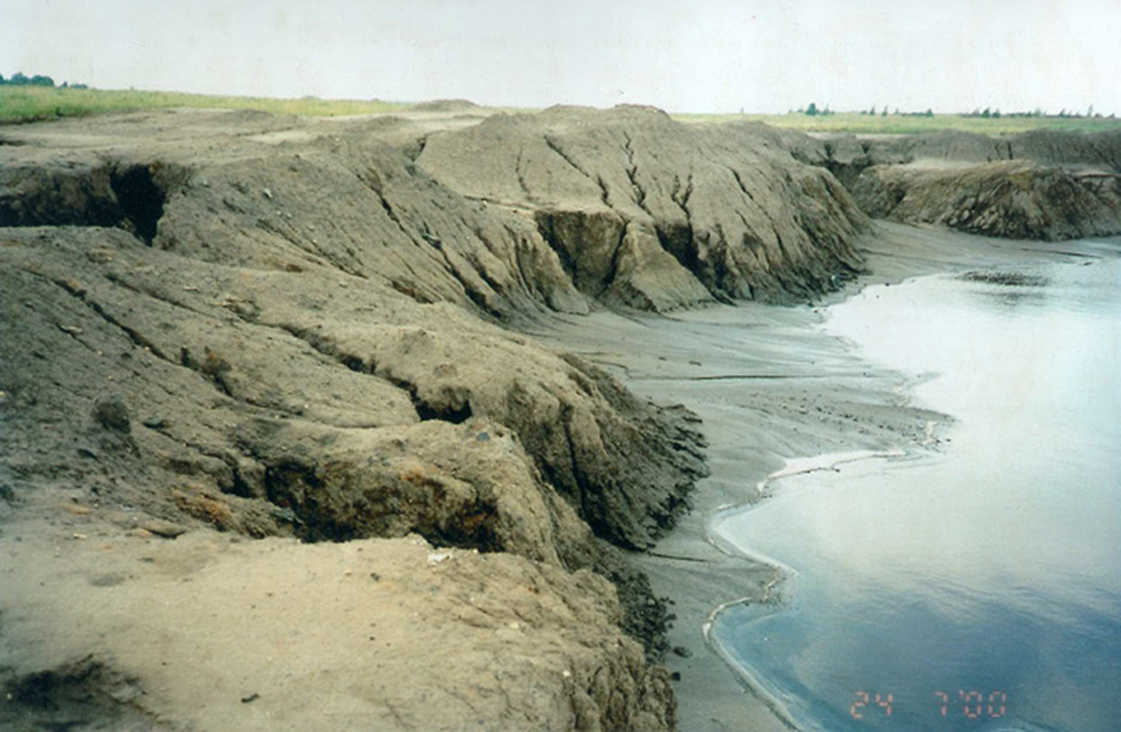
Table 11.5
The chemical composition of groundwater in open coal mining sites and in areas of underground coal gasification in the suburban coal basin
| Aquifer | Coal mining method | Variations in groundwater conditions | Prevailing temperature (°C) | pH | TDS (mg/L) | HCO3 (mg/L) | SO4 (mg/L) | Fe (mg/L) |
| Coal seam | Underground coal gasification | Naturally occurring | 6–8 | 7.0 | 252.2 | 147.0 | – | 6.8 |
| Inside the zone of influence of UCG—at a distance of 30–40 m from the gasifier | 20 | 7.5 | 1373.0 | 703.0 | 346.0 | – | ||
| Inside the zone of influence of UCG—inside the gasifier, inside the zone of the circulating gas/water vapor mixture | Up to 114 | 7.0 | 1243.0 | 738.0 | – | 52 | ||
| Condensate from the production wellhead | 400–600 | 6.4 | 12,473.1 | – | 4.0 | 997.0 | ||
| Open-pit coal mining (opencast coal mining sites) | Man-made “dead” pond with an acidic and very acidic environment | 20 | 2.7–5.0 | 1500–4460 | – | 1000–3100 | 25–531 | |
| Man-made water reservoir with a neutral and alkaline environment | 20 | 7.22–7.94 | 1480–1740 | – | 810–1010 | 0.05–3.2 |

As the table shows, in open-pit coal mining, even in man-made reservoirs with a neutral and alkaline pH, the presence of high concentrations of sulfates, iron, and TDS is recorded, which is significantly higher in comparison with during UCG operations.
The localized nature of the UCG-induced contamination was confirmed in studies conducted at the Yuzhno-Abinskaya UCG plant (Kuznetsk coal basin) and the Lisichanskaya UCG plant (Donetsk coal basin). As can be seen in Fig. 11.7, during water extraction, the concentration of phenol decreases, dropping below the MAC values post gasification and with continuing water extraction activities. Thus, it was proved that UCG-induced groundwater contamination was negligible and can be reduced to a minimum by means of adequate engineering and process measures.
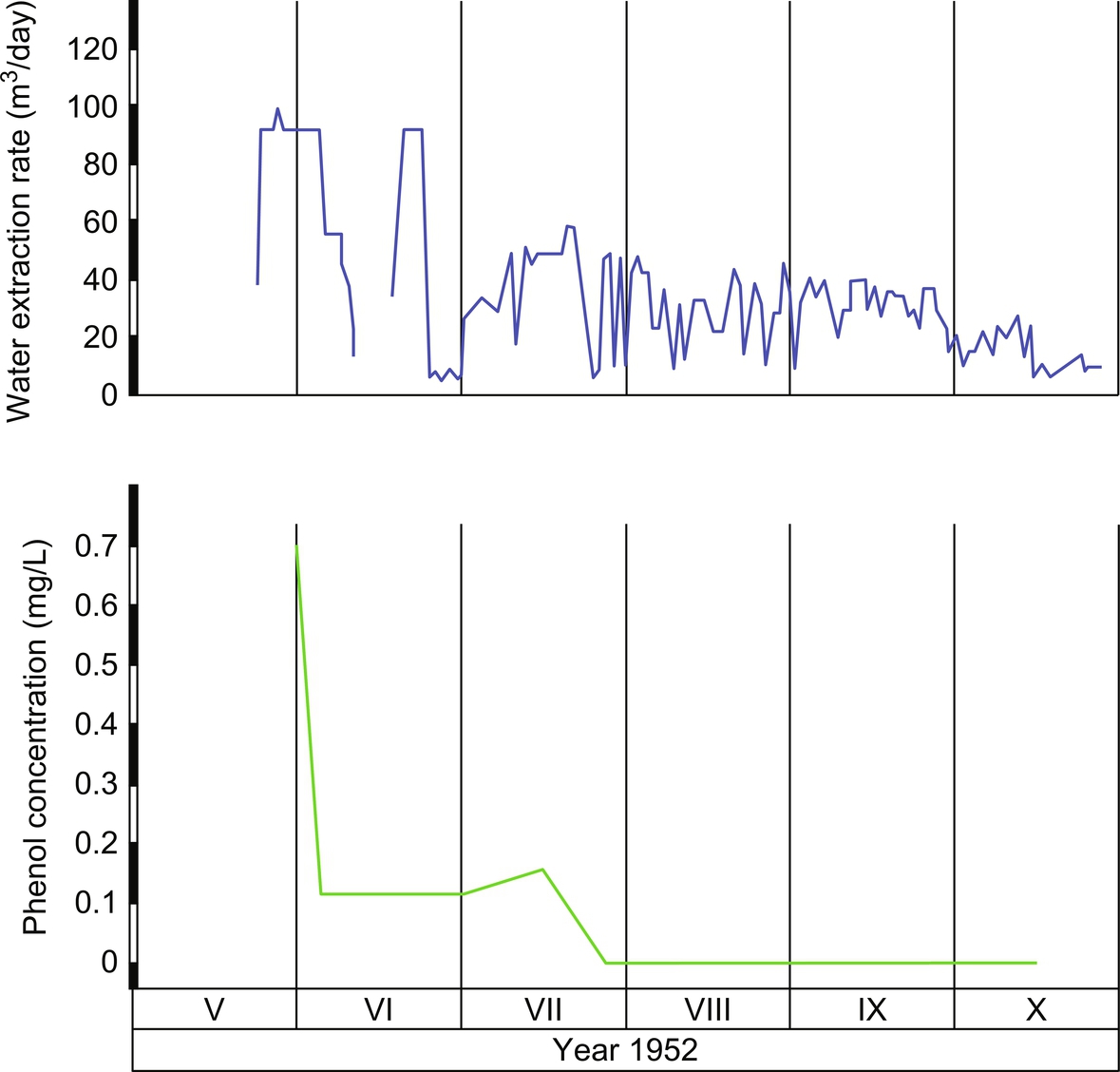
The Angren UCG site at the Angren lignite deposit (Uzbekistan) is another example with relatively suitable conditions. The lignite deposit is noted for its low coal seam permeability and surrounding rock and a confined groundwater system within the coal-bearing strata. The main Cretaceous-Paleogene aquifer system occurs at a considerable distance above the coal seam and is securely isolated from it by a thick layer of kaolin clays impermeable to groundwater and gas. However, during certain stages of the Angren UCG plant operation when gas was produced through vertical production wells, gas leakage occurred through breaches in process well casings. During certain periods of plant operation, gas leakage was as high as 24%. Gas migrated through the Cretaceous-Paleogene aquifer overlying the coal seam at a distance of 100 m. Phenols were occasionally detected in groundwater at the gasification panel at a concentration below 0.01–0.02 mg/L (Dvornikova, 2005). The gasifier design was subsequently modified at the Angren UCG plant. The updated design led to a reduction of the number of vertical wells with failed casings with gas leakage and virtually eliminated this as the source of contamination.
The above examples illustrate that the degree of aquifer contamination is a function not only of natural factors but also of the gasifier design, the condition of process wells, and UCG modes of operation.
Since 1990, large-scale environmental studies were conducted over 6 years at the UCG sites at the Yuzhno-Abinskaya UCG plant in the Kuznetsk coal basin, which have relatively favorable geologic and hydrogeologic conditions. A total of 2906 m of a network of groundwater monitoring wells was drilled as part of the studies. A systematized monitoring process was put in place to record changes in groundwater temperature, level, chemistry, and concentration of dissolved gas. The purpose of these studies was to determine the extent and variations over time of the contaminant migration beyond the boundaries of gasification sites. Also of considerable interest were the questions what percentage of contaminants remained in the underground gasifier and what amount flew out with groundwater flow post gasification. In addition to the results of studies obtained as part of this groundwater monitoring program, the monitoring results of previous years were used in the assessment and analysis of groundwater contamination.
Of important note is that the mining lease area of the Yuzhno-Abinsk UCG plant as a study area is quite complex due to the fact that as of the launch of the research study, the in situ gasification of coal seams of varying thickness and depth had been in operation for over 37 years in 21 gasifiers. The coal-bearing unit that is composed of steeply dipping coal seams and interbedded mudstones, siltstones, and sandstones has very low permeability and groundwater saturation. It is classified as intermediate between aquitards and aquifers. A gas condensate storage trench was installed in loam soil without a plastic liner and operated over a long period. There were some periods when the condensate was collected in spent gasifiers.
Studies were carried out in operating and spent gasifiers, in the vicinity of surface gas condensate storage, and outside of the mining lease boundaries. The monitoring period was 9 years for an operating gasifier and 4.5 years for depleted panels.
The following results were obtained:
1. The main source of the hydrosphere contamination was the condensate storage trench. At a distance of 12 m from the storage site, the concentration of phenols and ammonium ion was 15 and 225 mg/L, respectively, while 60 m away, their values were as low as 0.9 and 21 mg/L (Figs. 11.8 and 11.10B). The study showed that loam soil neither serves as a screen nor prevents contaminant migration (Dvornikova, 1996a,b,c, 2011). Condensate must be disposed into specially designed storage dams or properly lined condensate ponds.
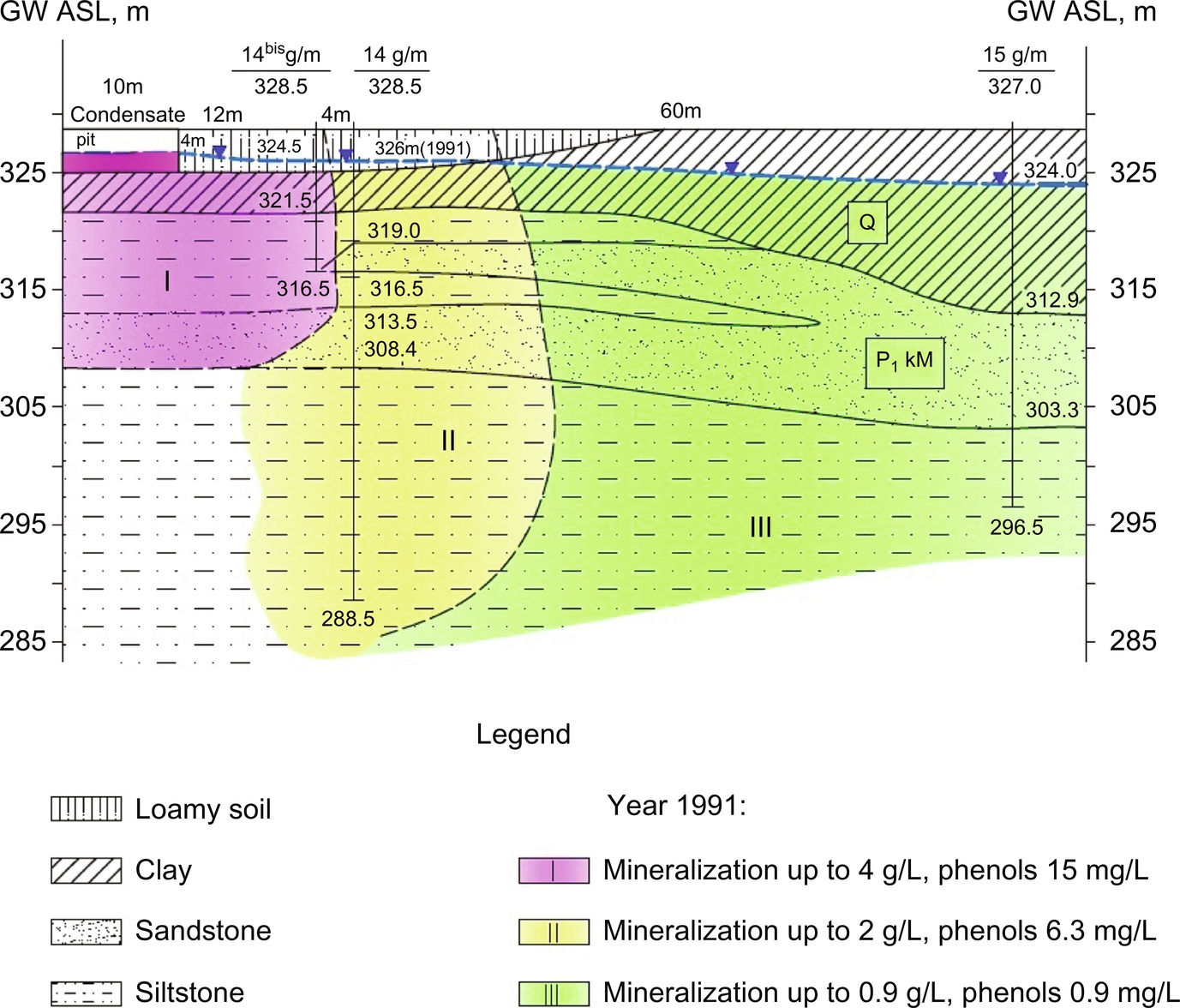
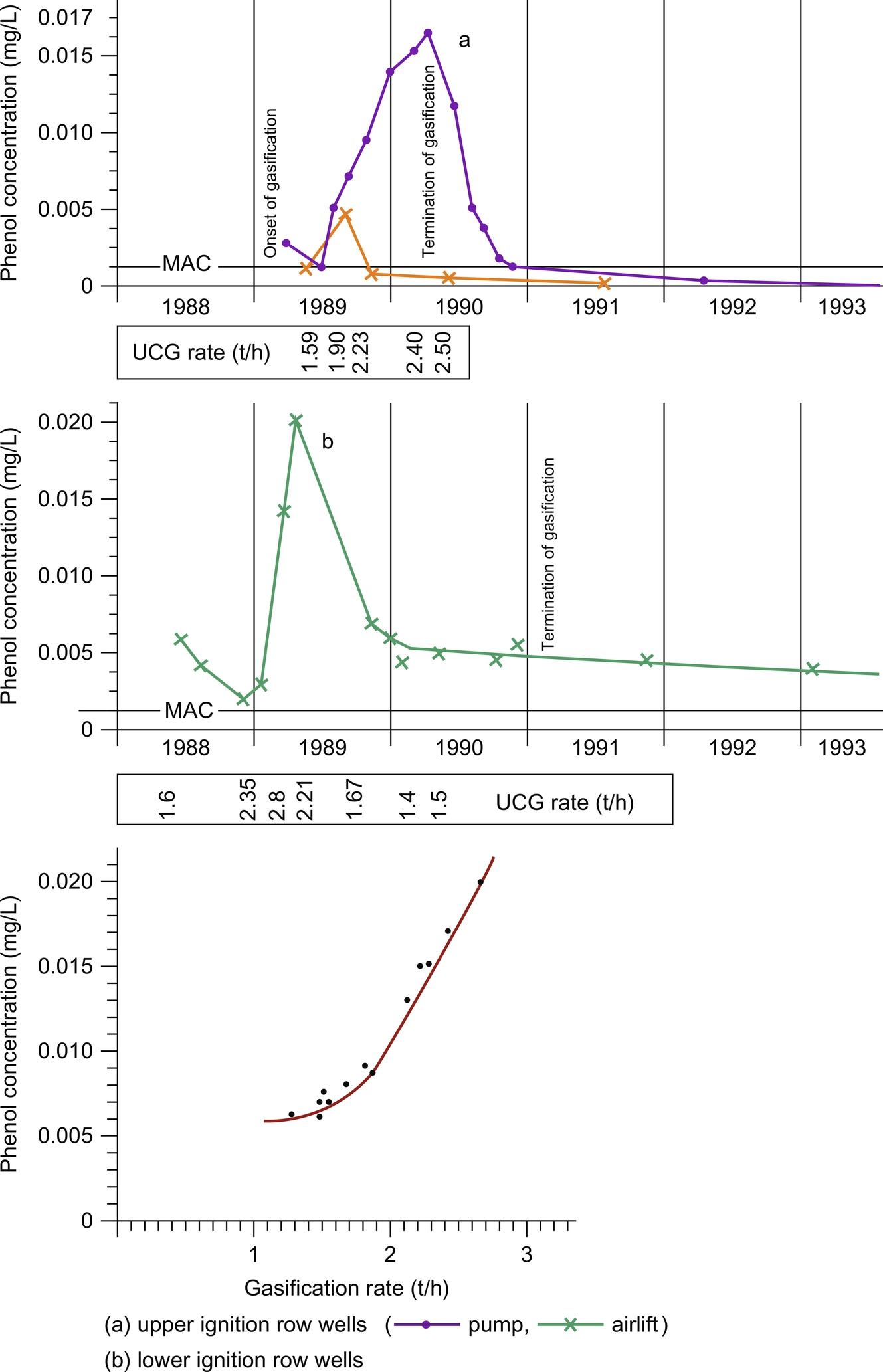
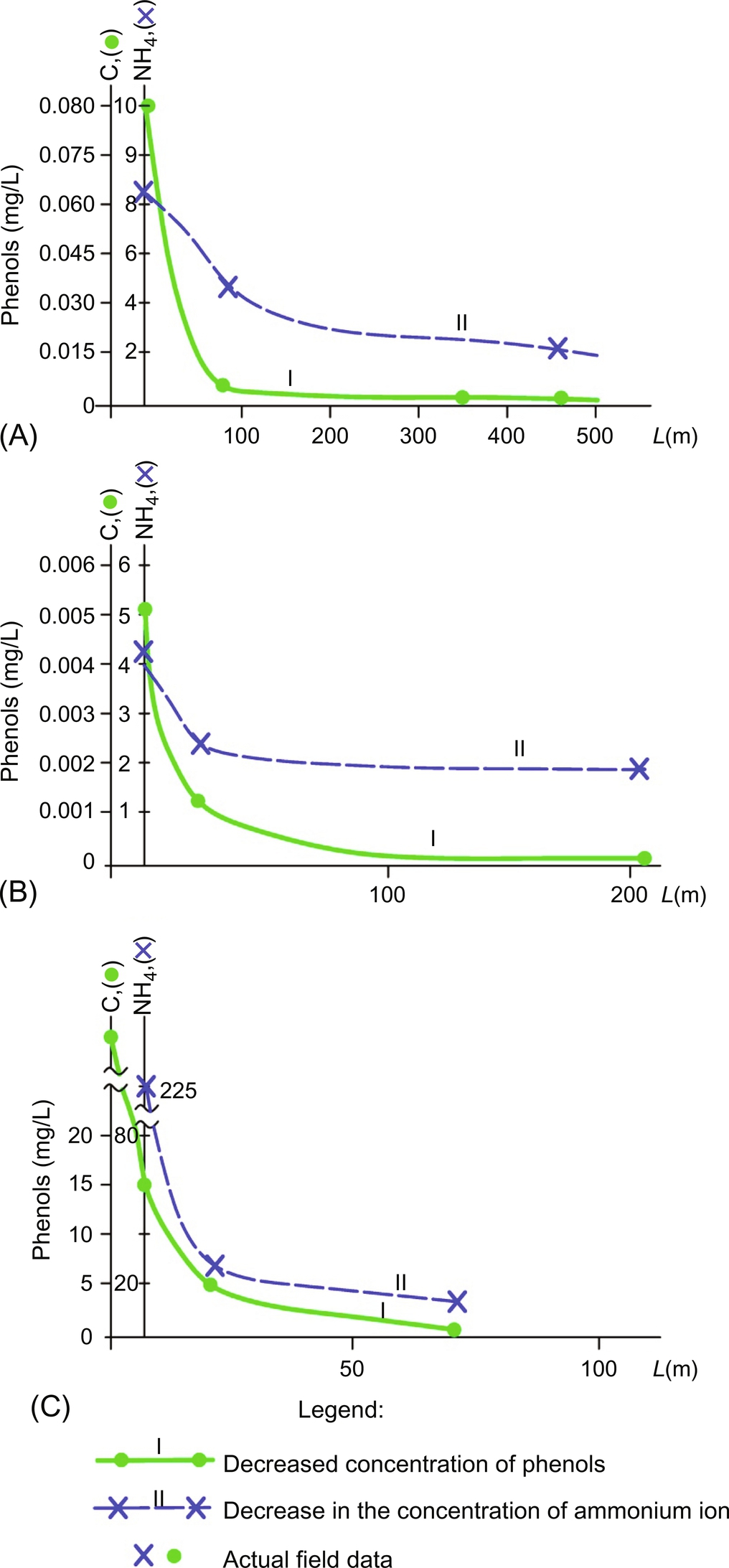
2. During UCG, groundwater undergoes significant changes throughout the gasifier panel. The concentration of carbon dioxide is as high as 90–150 mg/L; the concentration of TDS in groundwater pumped from the gasifier increases (from 400–600 to 1700–2000 mg/L); there is an increase in the concentration of iron ions (up to 2.0 mg/L) and sulfates (from 20 to 800 mg/L); the pH shift is down. The concentration of phenols does not exceed 0.02 mg/L (MAC = 0.001 mg/L), with ammonium ion at 40–60 mg/L (Fig. 11.9). The maximum contamination was recorded during the period of the most intensive stage of the UCG process and maximum gas leakage into the surrounding rock strata, while a deep groundwater depression cone persisted in the operating gasifier due to evaporation of groundwater and water extraction activities. The contaminated groundwater flow direction was toward the water extraction wells, toward the zone of decreased pressure.
By the use of a specially devised tower experiment during the gasification process, phenols were shown to be subject to rapid oxidation. Water extraction was performed from the depleted cavity through two wells drilled only 10 m apart, using a pump in one and airlift in the other. During groundwater airlift, the concentration of phenols decreased sharply (Fig. 11.9A), which indicated active oxidation of phenols. In the water extraction well where a pump was used, the concentration of phenol was as high as 0.017 mg/L, while at a distance of 10 m from the well, in the airlift well, the phenol concentration did not exceed 0.0045 mg/L (Dvornikova, 1996a,b,c, 2011). Subsequently, the results of the experiment were used to develop a method for clean UCG.
Some 90 m from the operating gasifier, inside the zone of condensation of vapor-phase water, the concentration of phenols and ammonium did not exceed 0.006 and 4.5 mg/L, respectively (Fig. 11.10A), while at a distance of 350–500 m from the operating gasifier, there were no exceedances of MAC values. This suggested that moisture was condensed to water near the fire source within a radius of no more than 250 m, where migration of gas leakage was at its most intense and a cone of groundwater depression formed. It was thus proved that thanks to the cone of groundwater depression, groundwater contamination was restricted to a localized area at an operating gasifier under conditions of the Yuzhno-Abinsk UCG plant.
As is known, UCG-induced contamination is directly related to gas leakage. Analysis of gas leakage showed that during UCG, gas leakage values averaged 7%–10% but at certain periods was as high as 15%. Maximum leakage values were recorded during periods when the ratio between the pressure in the underground gasifier (P) and the hydrostatic pressure in this section (H) exceeded 1.1. A series of experiments were conducted at an operating gasifier using a range of ratios between pressure P within the underground gasifier and hydrostatic pressure H of 0.5–1.1. Optimal (from the point of view of minimal impact on the ecosystem) modes of operation of the gasifier were devised, which generated gas with a calorific value of about 1000 kcal/m3 (Dvornikova, 1996a,b,c). The invention was then patented (Patent No. 2090750 “Method of underground coal gasification”) (Kreinin and Dvornikova, 1997). In order to reduce gas leakage (Kreinin and Dvornikova, 1997), the LPUCG method was also recommended (Blinderman, 1995), which ensures minimum pressure in the underground gasifier system and, consequently, minimal contamination of the hydrosphere. A comprehensive process solution was developed to minimize groundwater contamination and subsequently patented (Karasevich et al., 2009a,b). As a result of large-scale, multiobjective environmental studies, it was proved that improving the environmental impact during UCG is possible through achieving optimal operating conditions and the gasifier design.
3. After the completion of UCG operations while water extraction was still ongoing, the concentrations of the contaminants were reduced to values below the MAC (Fig. 11.9A).
4. Immediately after the cessation of UCG and water extraction activities from the depleted gasification cavity, groundwater levels recover naturally over time. A gradual decrease in the concentration of TDS was recorded: 3 years post gasification, from 2000 to 1100 mg/L, and at a 5-year mark, down to 800 mg/L (baseline value 400–600 mg/L). Without forced inflow of groundwater (no ongoing water extraction), the concentration of phenol in the depleted gasification cavity does not exceed four times the MAC (0.0037 mg/L), while the concentration of ammonium ion is 7.3 mg/L.
5. Groundwater in the depleted cavities of abandoned gasifiers is metamorphosed. A common finding among them is an increased content of carbon dioxide at a concentration of an average of 70 mg/L, ammonium ion 4–8 mg/L, and phenols 0.002–0.005 mg/L. The maximum degree of contamination was recorded in UCG panels with thick coal seams (4 and 8 m). Beyond the boundaries of depleted UCG panels, concentrations of contaminating components do not exceed the MAC, which suggests self-purification of groundwater due to sorption processes occurring in the rock formation (Fig. 11.10B).
To evaluate and validate the theory of self-purification of groundwater, special laboratory studies of the sorption properties of coal sampled from a depth of 300 m were conducted. The assumption as to high sorption capacity of Yuzhno-Abinsky coal was confirmed. The adsorption capacity of raw and heated coal with the initial concentration of the solution of 0.04 mg/L was 2.5 and 9.0 μg/g, respectively. By way of comparison, the adsorption capacity of activated carbon is 13 μg/g. With equilibrium concentrations of phenol being 0.7–0.8 mg/L, the adsorption capacity of raw and heated coal was 0.13 and 0.22 mg/g, respectively (Dvornikova, 1996a,b,c).
The contaminated groundwater flow in the coal seam from the direction of depleted UCG panels moves primarily through heated coal that is subject to water vapor exposure, through the zone where processes of the sorption of contaminated components are actively going on, resulting in self-purification of groundwater. The results of long-term and large-scale field studies proved that at the Yuzhno-Abinskaya UCG plant, groundwater contamination in the depleted gasification panels was confined to a localized area, with contaminants being adsorbed by the heated rock whose sorptive capacity properties increase sharply as the heat penetrates through coal and the surrounding rock material.
The Henry's isotherm constant and distribution coefficient ß, which were obtained as a result of laboratory studies of high volatile bituminous grade coal, were used in calculations and predictions of the migration of contamination plumes. Calculations were performed using the conductivity profile model “ρο” from the spent gasifier and condensate discharge site. The calculations took into account the hydrodynamic and conductivity properties of the rock strata, as well as the spent gasifier sites characterized by increased sorption capacity values (Dvornikova, 1994).
Presented in Fig. 11.11A are the calculation curves of phenol concentrations in groundwater for different periods of time and patterns of their decrease in the center of the contamination plume during migration from the spent gasifier. Analysis of the data confirmed a decrease in the concentration of phenols along the migration path of the plume and over time (Kreinin and Dvornikova, 1999). The results of calculations based on the conductivity profile model “ρο” are reasonably consistent with the actual data recorded during the long-term groundwater monitoring period. Fig. 11.11B shows data on the calculated concentrations of phenols in different sections located 30, 90, and 210 m away from the spent gasifier, respectively. The variation curves of the phenol concentration over time show extreme amplitudes. A slight increase in the concentration of phenols (0.0017 mg/L) was recorded at a distance of 90 m from the abandoned gasifier 8 years post gasification.
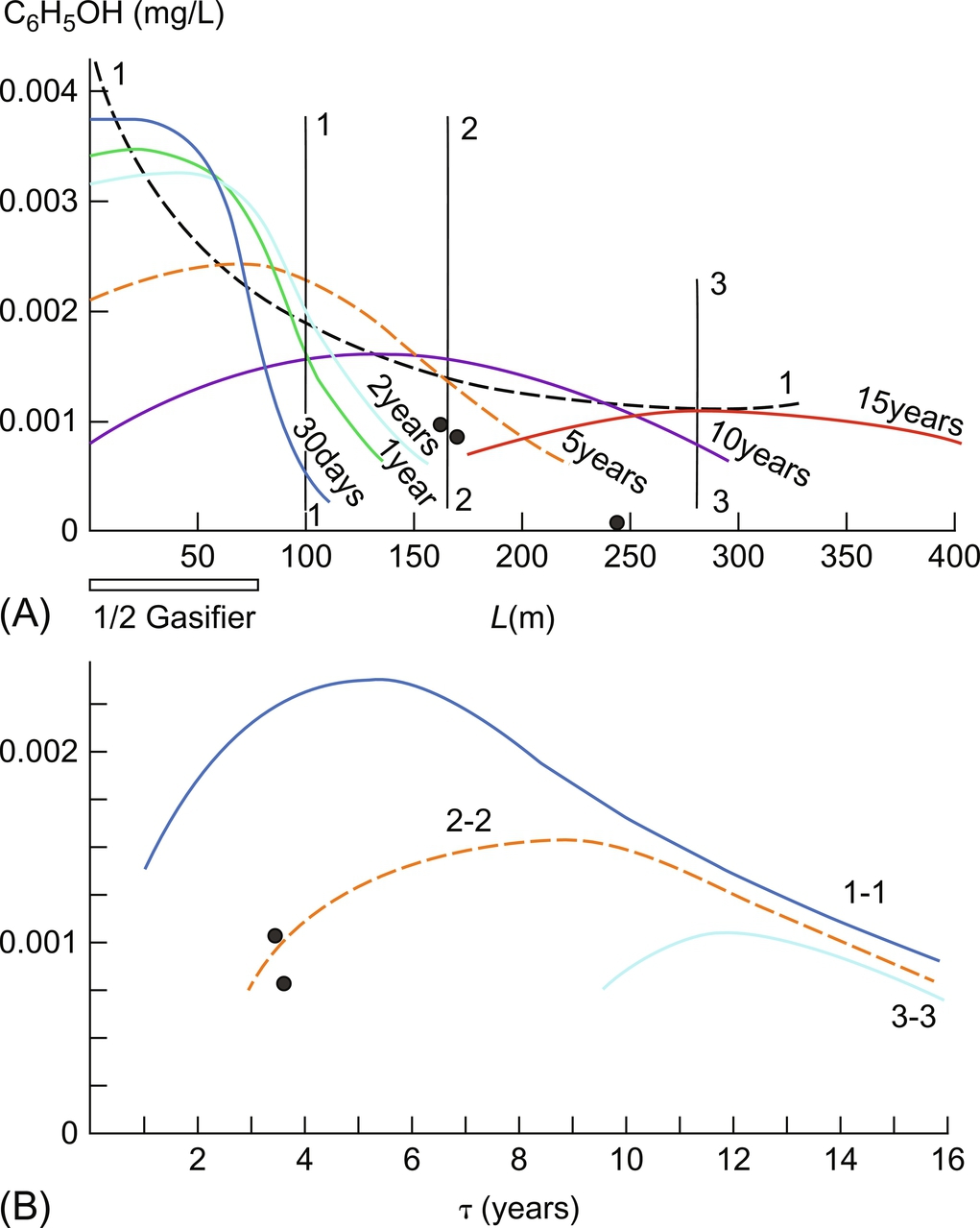
To minimize residual contamination (phenols) in the depleted cavity, a groundwater treatment method was developed using biochemical oxidation of organic compounds in alkaline conditions, whereby special bacteria and oxygen of air were injected through process wells (Karasevich et al., 2009a,b).
The studies conducted at the Yuzhno-Abinskaya UCG plant located in the Kiselevsk coal deposit showed the following:
1. Groundwater contamination during the operation of the UCG gasifier is localized to the gasification site.
2. The principal contaminants of concern (phenols, tars, rhodanides, cyanides, and ammonium) are volatile, become entrained gas mixture, and are to the surface as condensate.
3. The maximum contaminant concentration is noted during the gasification period, with a cone of groundwater depression surrounding the gasifier, which prevents the spread of contamination. It was experimentally proved that three months after the cessation of gasification, with continuous water extraction, the concentrations of phenols do not exceed the maximum allowable concentration.
4. UCG should be applied using optimal (in terms of minimum damage to the ecosystem) modes of operation of the gasifier with a certain ratio between the pressure in the underground gasifier (P) and the hydrostatic pressure (H).
5. After the UCG processes have run their course, it is necessary to pump the groundwater out of the gasification cavity to ensure a thorough removal of contaminants to the ground surface followed by their treatment.
6. Once water extraction activities are completed, localized sources of contamination should be eliminated by flooding, with processes of oxidation and decomposition of phenols activated.
7. Post gasification, the degree of groundwater contamination in abandoned sites is negligible (2–5 MAC).
8. As contaminants migrate beyond the boundaries of depleted UCG panels, their concentration levels decrease to values close to the MAC due to sorption by coal and rock. Natural self-purification of groundwater ensues. Outside the mining lease area, groundwater contamination was not recorded.
9. UCG site is selected first and foremost from the standpoint of possible environmental impacts, assessing primarily the mining, geologic, and hydrogeologic conditions of the coal field.
Analysis of long-term ecological studies conducted at the Yuzhno-Abinskaya UCG plant and at certain periods at the Lisichanskaya, Podmoskovnaya, and Angren UCG plants showed that the UCG-induced environmental impacts are predictable and can be controlled and mitigated using relatively simple engineering measures. A set of measures was developed to protect groundwater from contamination, which makes it possible to reduce the UCG impacts to a minimum.
11.5 Environmental performance in recent UCG projects
In the United States, first UCG trials were conducted at the Gorgas, Alabama site. In 1975, Texas Utilities obtained a UCG technology license in the former USSR, and its subsidiary Basic Resources, Inc. conducted the first UCG trial in Texas assisted by Soviet experts. The results of the first experiments became the basis and comparative criteria for subsequent theoretical and laboratory studies and field tests conducted during the ensuing years. Prior to 1992, around 30 experiments were conducted in natural conditions in coal deposits in five states (Wyoming, West Virginia, Illinois, New Mexico, and Texas).
The largest research project was implemented at the Rocky Mountain 1 site in the Hanna coal deposit. The coal seam had a thickness 10 m occurring at the depth of 130 m. The seam was subhorizontal. The test project duration was 100 days. A special program was designed to assess the environmental impacts, which included the following:
− Development of requirements for environmental protection
− In-depth studies of the hydrogeologic conditions at the UCG site prior to the start-up of operations
− Monitoring of the experiment
− Water extraction from depleted gasification cavities
− Geochemical studies of groundwater and condensate
The experiment was successfully completed in 1988.
The results of these studies confirmed some conclusions reported previously in the USSR:
− UCG-induced groundwater contamination is localized to depleted gasification cavities.
− The cone of groundwater depressions is still present in the vicinity of the cavity, with groundwater flow direction toward the cavity.
− After the depleted cavity was allowed to flood, water extraction was conducted from two cavities with the help of submersible pumps, followed by water treatment in an aboveground three-stage water treatment system and subsequent discharge to the ground surface.
− During water extraction activities, a decrease in the concentration of phenol was recorded (Fig. 11.12), as well as boron and ammonia to below detection limit, 0.02 mg/L.
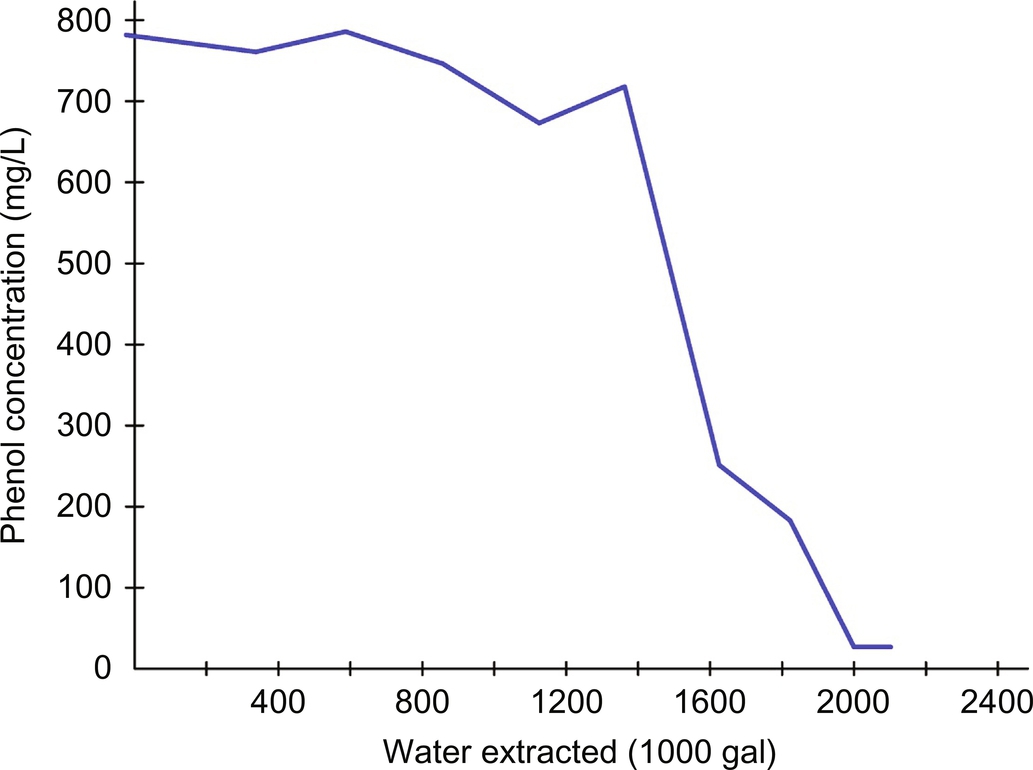
− The bulk of groundwater that was subjected to the impacts of UCG is pumped out from the cavity, thereby reducing or eliminating the possibility of aquifer contamination (Speight and Covell, 1989).
− The water treatment system selected for removing ammonia and phenols was successful, but for the removal of other contaminants, the water treatment system should be improved.
− During site selection, attention should be given to the mining, geologic, and hydrogeologic conditions of the site.
Therefore, favorable environmental impacts of the UCG technology were confirmed.
A study of the possible UCG-induced groundwater contamination was carried out in the Surat coal basin in Australia. The pilot UCG project was launched in 1999 by Linc Energy and Ergo Exergy near Chinchilla, some 350 km from Brisbane. The pilot UCG plant was operational for more than 30 months. The controlled shutdown of the gasifier was commenced in January 2002. The UCG project in Chinchilla was the largest in scale and longest-operating in the West. It should be noted that since the UCG project at Chinchilla was the first of its kind outside the former Soviet Union and was developed on a commercial basis, strict confidentiality standards were maintained, with only limited disclosure of findings (Blinderman and Fidler, 2003).
The coal deposit is characterized by quite favorable conditions for UCG. The coal seam is 10 m thick at a depth of 140 m surrounded by low-permeability rock strata composed of clays, clay sandstone, mudstone, and siltstone. The dimensions of the gasifier were 200 by 150 m.
Environmental monitoring studies of groundwater systems were conducted at the coal deposit. Prior to initiation of UCG operations at the pilot gasifier, 13 groundwater monitoring wells were drilled. Monitoring occurred in two zones:
− Inner zone with a radius of 300 m from the center of the gasifier containing six groundwater monitoring wells, two of which within 50 m and the rest at a distance of 130–180 m
− Outer zone at a distance of 350–1750 m from the gasifier containing seven groundwater monitoring wells
Inside the inner zone, five wells were drilled and instrumented with piezometers (Fig. 11.13).
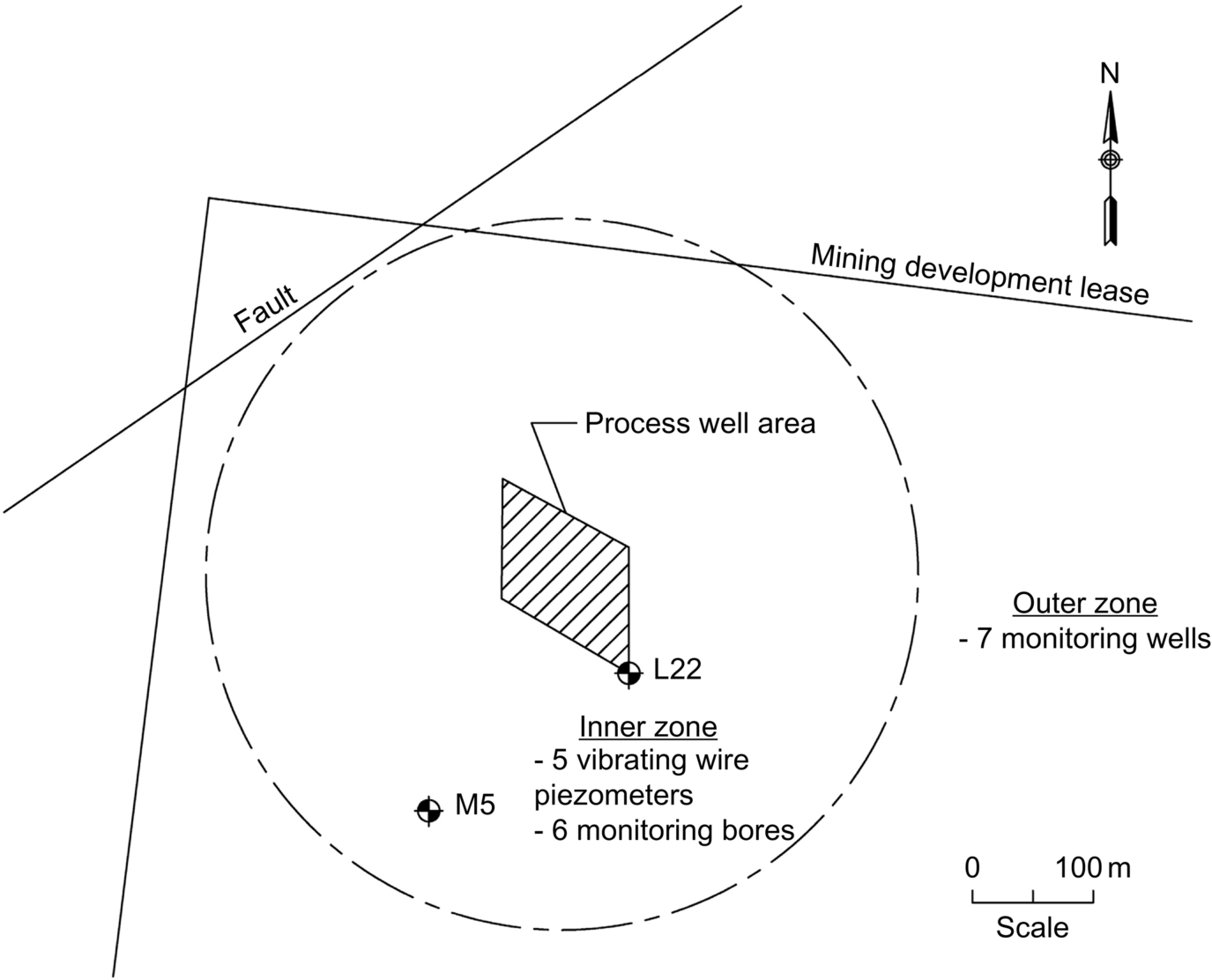
Gasification was carried out at pressures below the hydrostatic pressure throughout the service life of the gasifier.
To stop gasifier operation, a special program of controlled shutdown was developed. The shutdown program entailed a continued gasification phase under reduced pressure. Eventually, air injection into the underground gasifier was cut in mid-April 2002, with UCG operations completion in April 2003.
Monitoring of hydrodynamic and geochemical groundwater conditions supported the findings obtained previously in the USSR and the United States as follows:
1. During UCG, the groundwater flow direction is toward the underground gasifier area. Contamination is localized.
2. The maximum contaminant concentration levels are found in the condensate (Fig. 11.14), which confirms the conclusion that during UCG operations, most contaminants are entrained with the gas mixture and brought up to the surface where it can be treated.
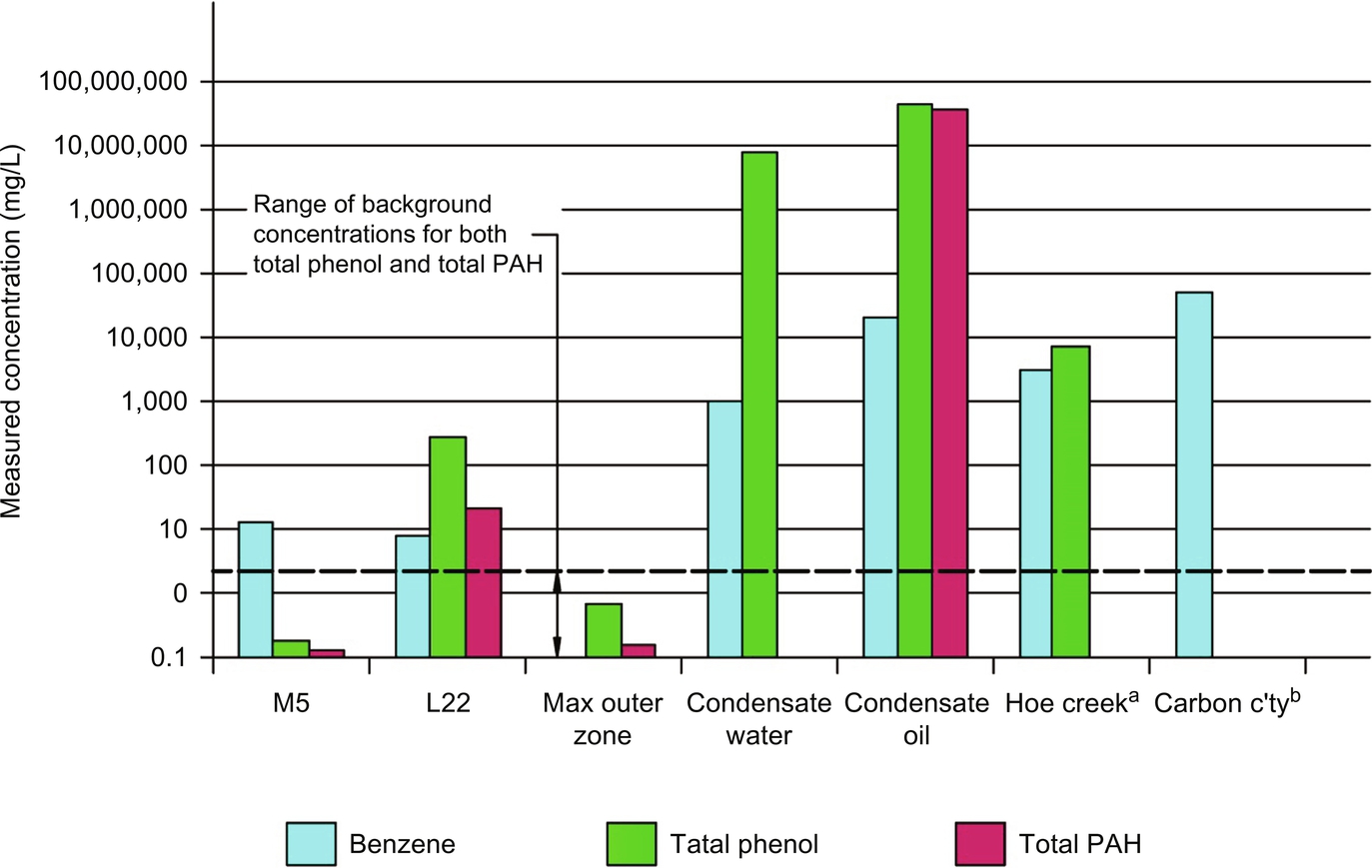
3. The increased concentration of contaminants was noted only in wells connected into gasification cavity. No contamination was detected in the groundwater monitoring wells. After termination of UCG operations, the concentration of contaminants inside the gasification cavity was consistently decreasing.
One of the important aspects of the project was the proprietary system of groundwater protection using hydraulic circulation system developed by Ergo Exergy. This system consisted of several wells with an in-seam interconnectivity. This technique permitted cleaning the spent gasifier from contaminants using water injection or by injection of biological agents into one of the wells.
In 2002, Eskom Holding (South Africa) entered into an agreement with the Canadian-based technology provider Ergo Exergy to develop the Majuba coal field in the province of Mpumalanga. Hydrogeologic and environmental investigations in the mining lease were initiated in 2005 and continue to the present.
At the pilot UCG site, the subhorizontal coal seam with a thickness of 4.2–5.35 m was intersected at a depth of 266–300 m (coal seam floor). Four aquifers are identified at the study site. Groundwater monitoring wells were installed in the shallow aquifer that is nearest to the ground surface, the intermediate upper and intermediate lower aquifers, and the deep coal seam aquifer.
The investigations bore out the results of previous studies conducted in the former USSR, the United States, and Australia:
1. During UCG, the cone of groundwater depression was continuously present localizing the contamination.
2. After termination of UCG operations, the groundwater level gradually recovered. Thanks to the water level recovery, a zone of decreased groundwater heads persists in the vicinity of the gasifier for a long time. The groundwater flow direction is toward the spent gasifier cavity. Decreased contaminant concentration is noted.
3. Environmental protection measures, including hydrodynamic impacts on the aquifer, were instituted making it possible to control the groundwater contamination.
Thus, large-scale studies conducted in various mining, geologic, and hydrogeologic conditions, at commercial UCG plants in the former USSR, and during experimental and research programs in the United States, Australia, and South Africa showed that with an adequate mode of operation of a UCG gasifier, gasifier design, gasification, and dewatering regimes and complying with environmental protection measures, it is possible to conduct coal mining operations using the UCG method without detriment to the environment.
11.6 Conclusions
Presently, the world's coal consumption in electricity generation is significant: 70% in China, 56% in the United States, and 40%–60% in Western Europe. Coal resource tonnage significantly exceeds the total oil and natural gas resources. Considering the growing shortage of natural gas, the use of coal for energy production can be expected to increase in the near-term future. However, as was discussed above, the use of conventional coal mining methods has considerable environmental disadvantages. Modern environmentally friendly coal technologies, notably including UCG, will permit a reduction in stress to the environment in coal mining regions.
This chapter discusses the formation of the zone of man-made impacts on the hydrolithosphere and defining principal parameters. The types and nature of man-made changes in the hydrolithosphere are identified, as well as the nature of the physiomechanical and physiochemical processes inherent in the UCG, which largely determine the degree of groundwater contamination. The chapter also incorporates a classification of the major factors that determine the chemical composition of groundwater and the contamination plume, which together constitute the main environmental impact factors of UCG. For convenience, all factors are subdivided into two main groups: man-made and naturally occurring factors. Each factor and its effects on the hydrosphere are described individually, although during the actual operation of the UCG gasifier, the factors are not isolated from one another but rather interrelated. It should be emphasized that depending on the natural setting, some factors may play a pivotal or secondary role, while others may not play any distinctive role in groundwater chemistry. Not infrequently, major impacts of some factors may give way to the influence of other, more dominant factors under different conditions, which is a common occurrence in UCG, with continual changes in temperature, pressure, hydrodynamic, and geomechanical conditions.
Analysis of large-scale environmental studies conducted in the USSR, where a number of commercial and pilot UCG plants were in operation, and select pilot studies in the United States, Australia, and South Africa showed that potential groundwater contamination by the products of in situ coal gasification products is restricted to a localized area and can be completely removed or reduced to a minimum.
The model prediction contamination plume spread using the conductivity profile model that takes into account the anisotropy and conductivity nonuniformity of rock, gravitational differentiation, and physiochemical interaction of the contaminated stream with rock (sorption) is solidly backed up by the results of long-term studies.
Most contaminants are carried along with the gas flow to the surface in the form of condensate. The maximum contaminant concentration is recorded during the in situ coal gasification period, with a cone of groundwater depression surrounding the gasifier, which prevents the spread of contamination. Once the UCG operations have been completed, continued water extraction brings the concentration of contaminants down to levels below the maximum allowable concentration for drinking water. After groundwater levels recover, migration of contaminants from the depleted gasifier occurs primarily through heated coal, which is noted for high sorption capacity, contributing to the self-purification of groundwater. Specialized studies of the adsorption properties of raw and heated coal showed high phenol adsorption values.
UCG site selection should first and foremost consider possible environmental impacts. The classification of environmental impact factors should serve as a basis for the choice of an appropriate UCG mining method, gasifier design, mode of dewatering and gasification operation, and the need to develop environmental programs.
The investigation results presented highlight the multifaceted nature of protecting groundwater from contamination during UCG operations. Future efforts would do well to pursue development in the following areas:
− Investigate transport of solutions through heated and burned rock and coal in laboratory conditions and determine their sorption properties.
− Conduct field studies of groundwater flow and transport in specific geomechanical aquifer settings, specialized tracer testing.
− Study physical and chemical parameters of the coal seam, which are necessary to predict contaminant dispersal velocity and for the development of environmental protective procedures.
To provide effective solutions to eliminate possible adverse effects of UCG technology, close attention is required to the scientific and methodological aspects as early as the site evaluation and exploration stage, as well as gasifier design and operation.
The geologic and hydrogeologic conditions of each coal deposit mined using the UCG method offer a unique set of challenges both in determining the extent and scale of potential adverse effects on the hydrosphere and developing methods of prediction to develop cost-effective, environmentally protective solutions.